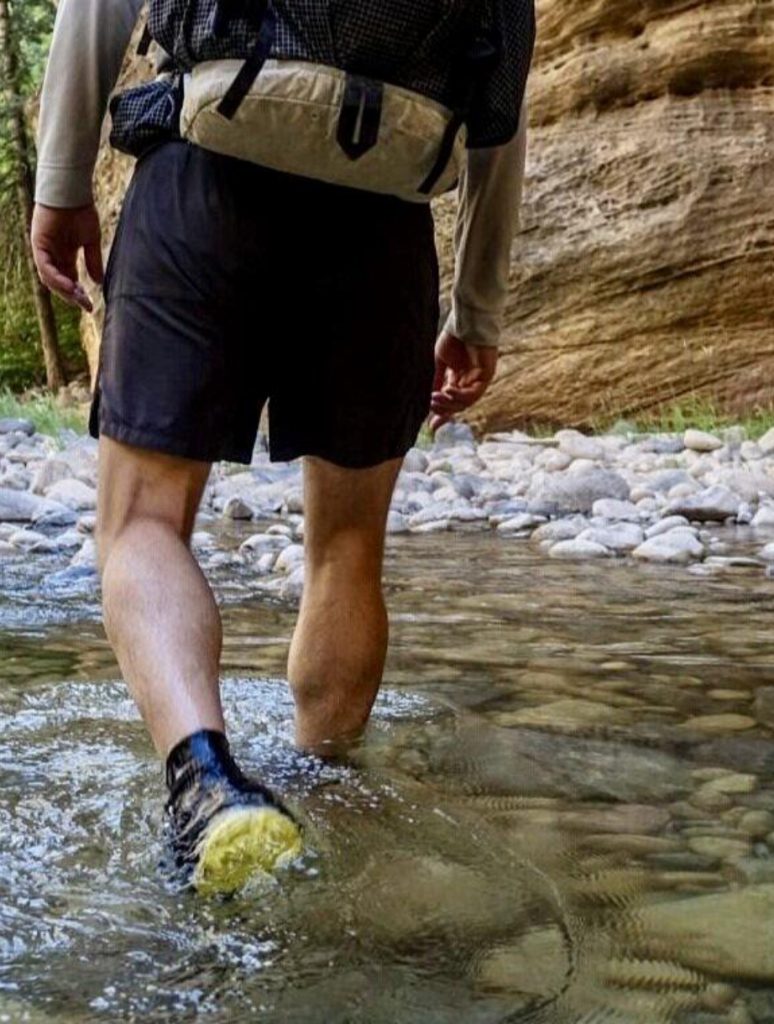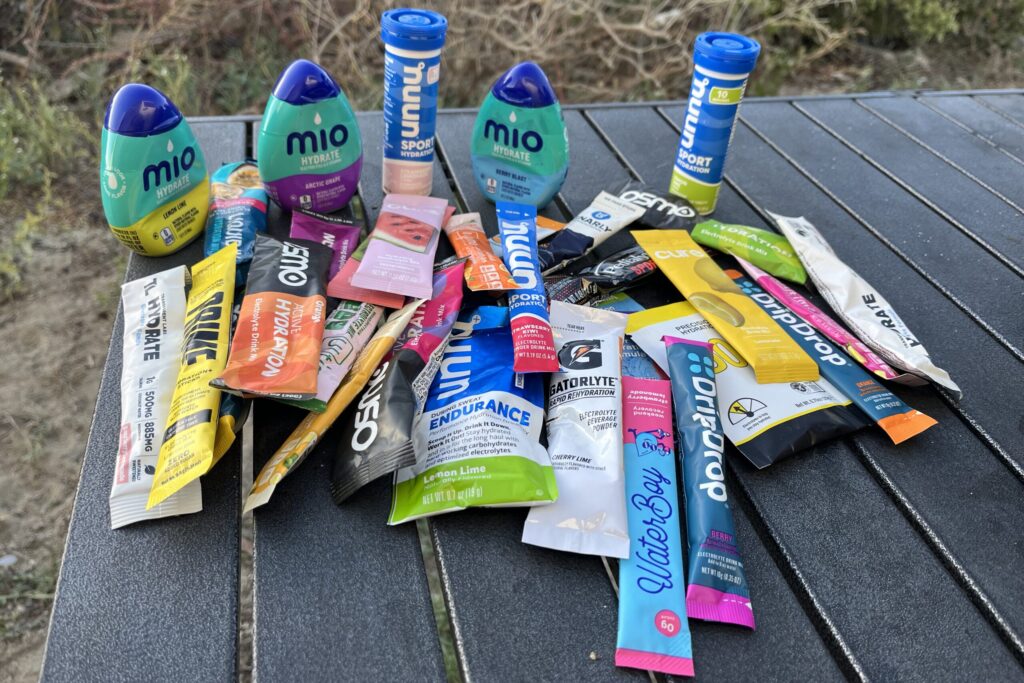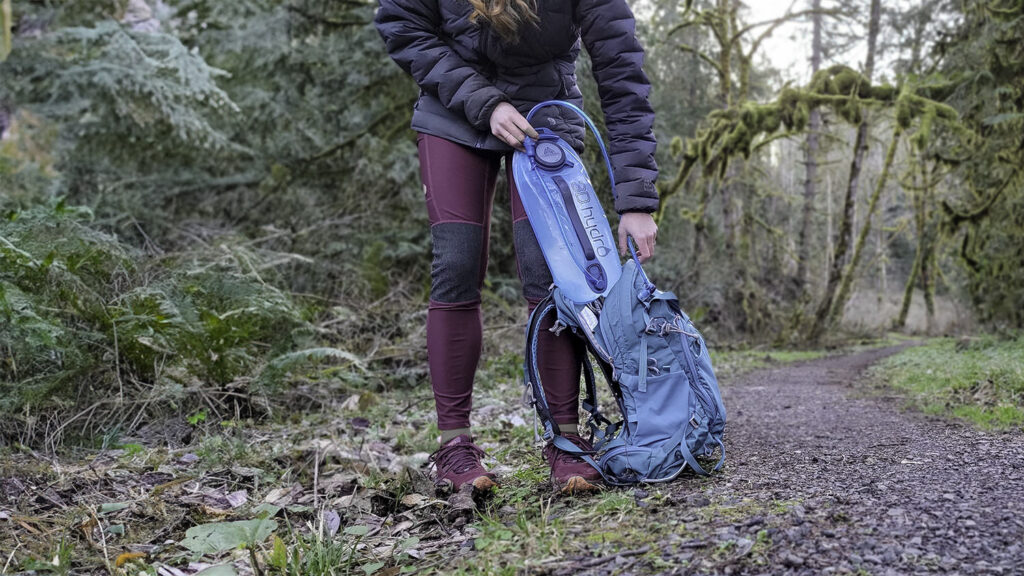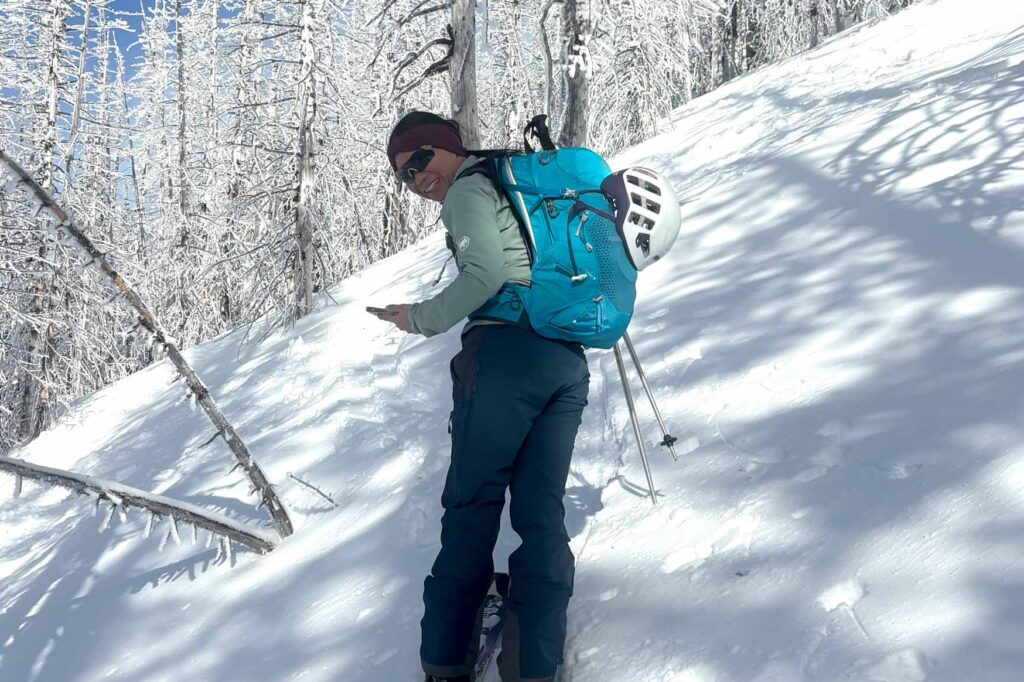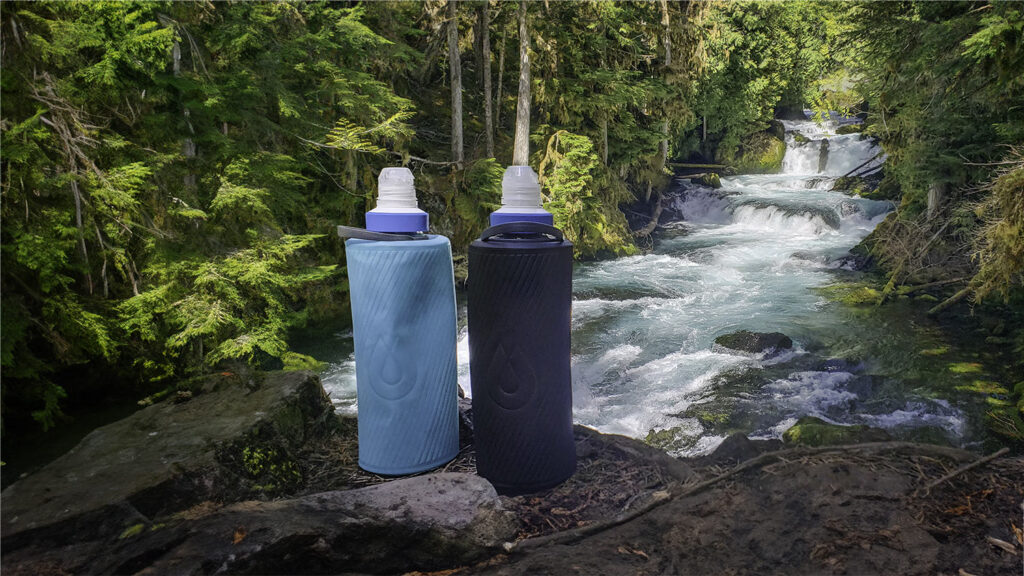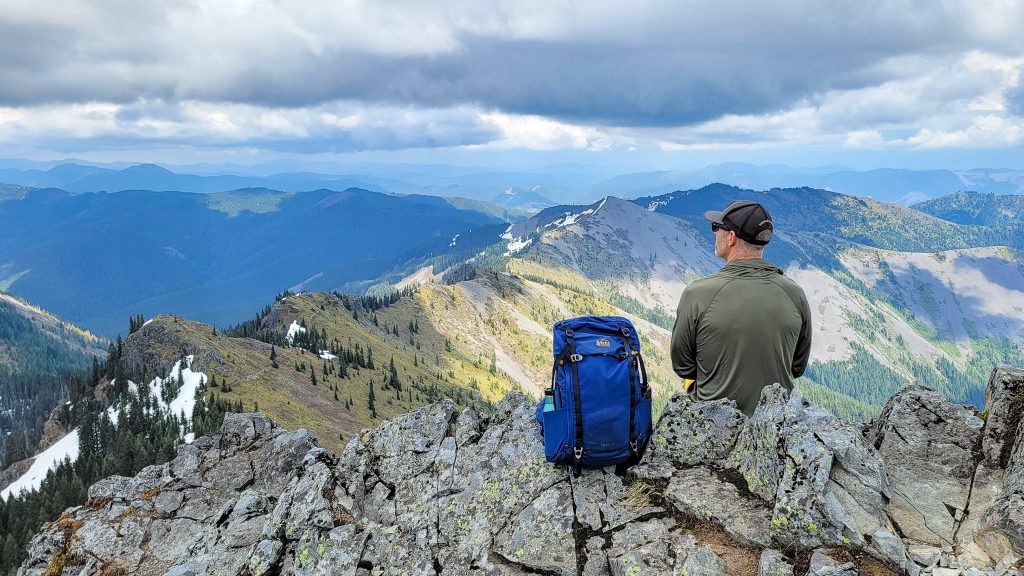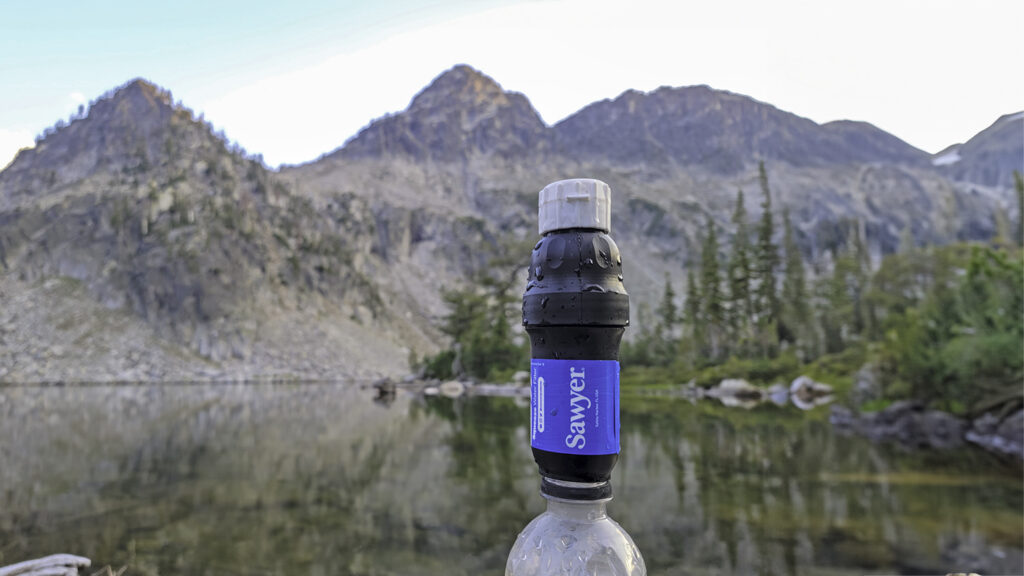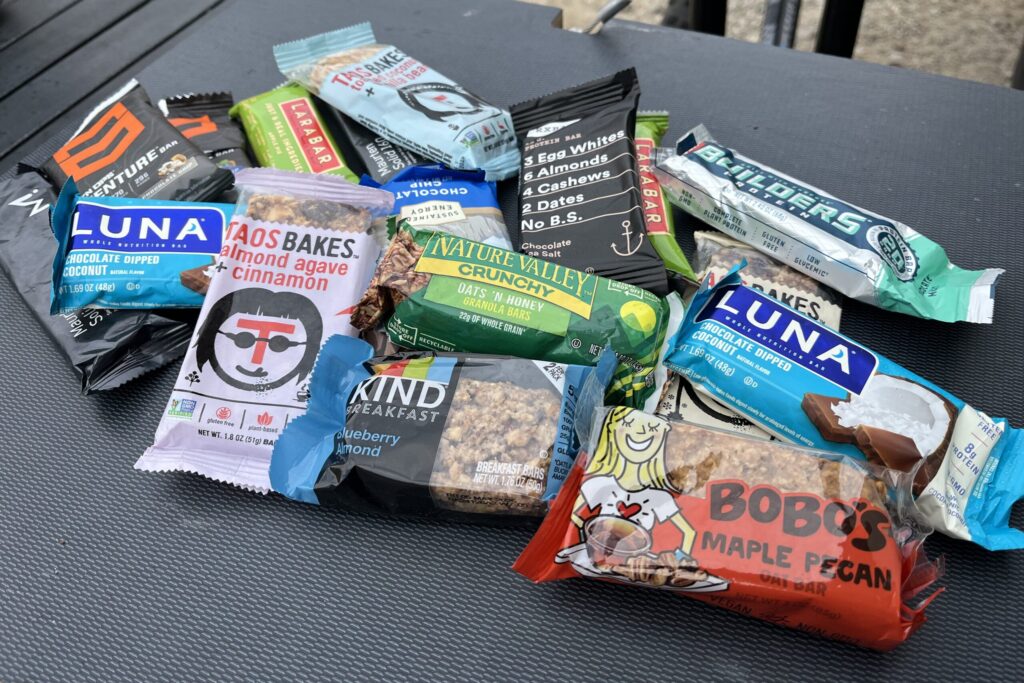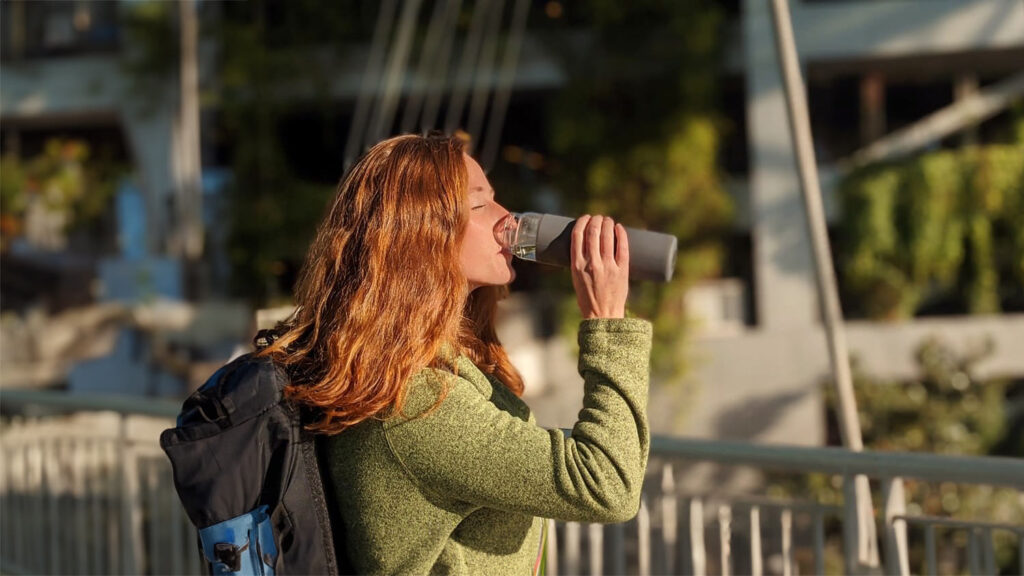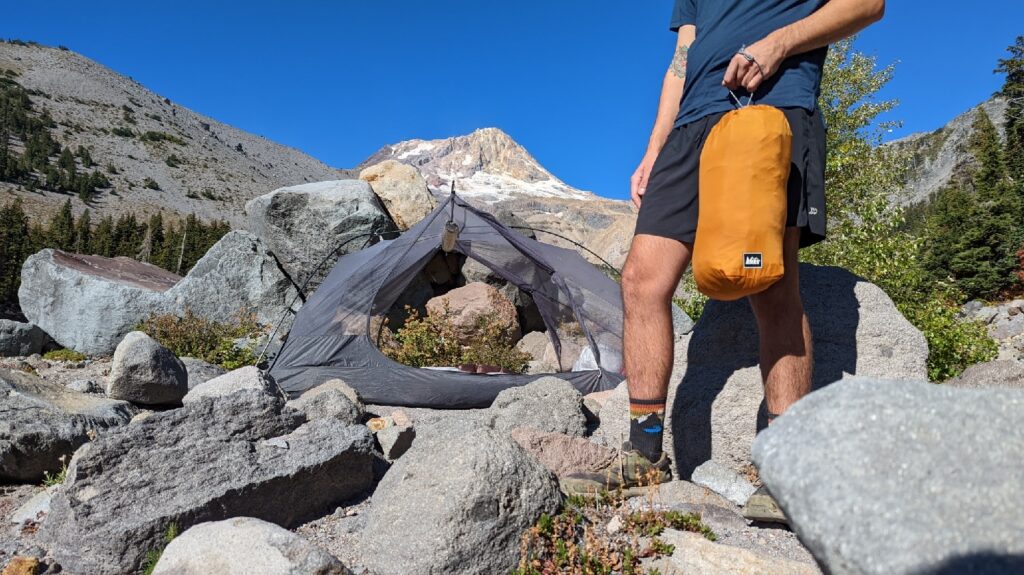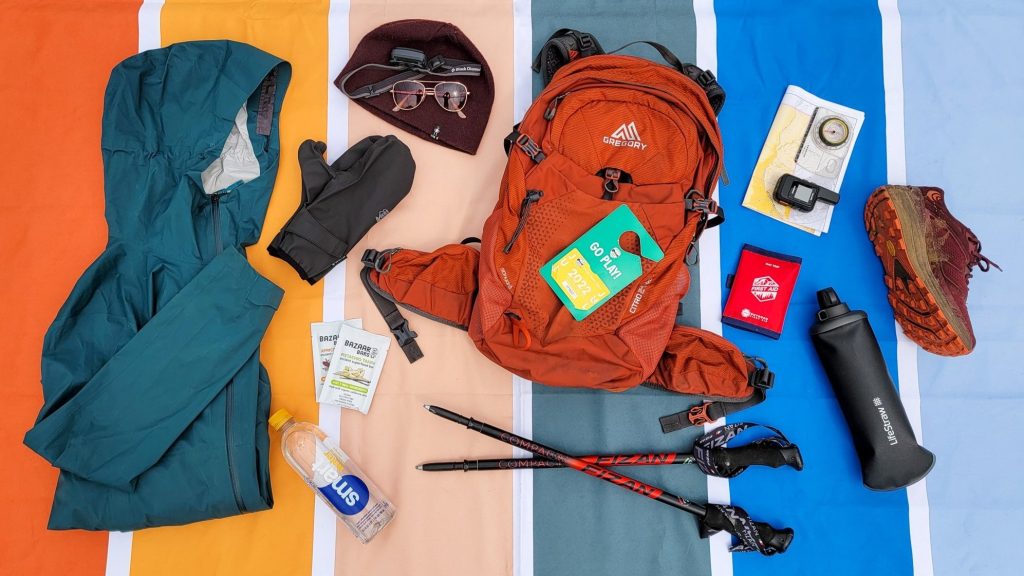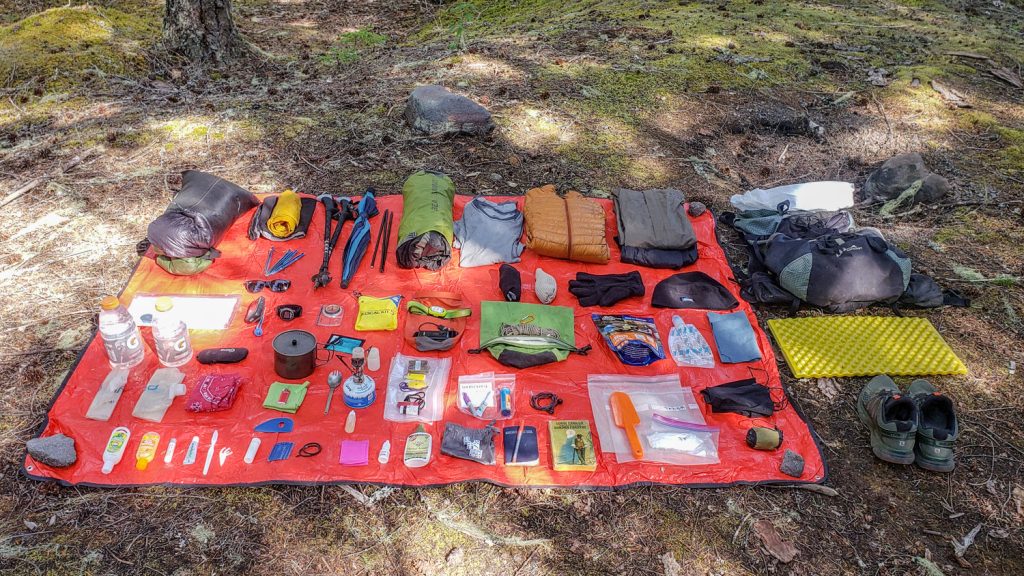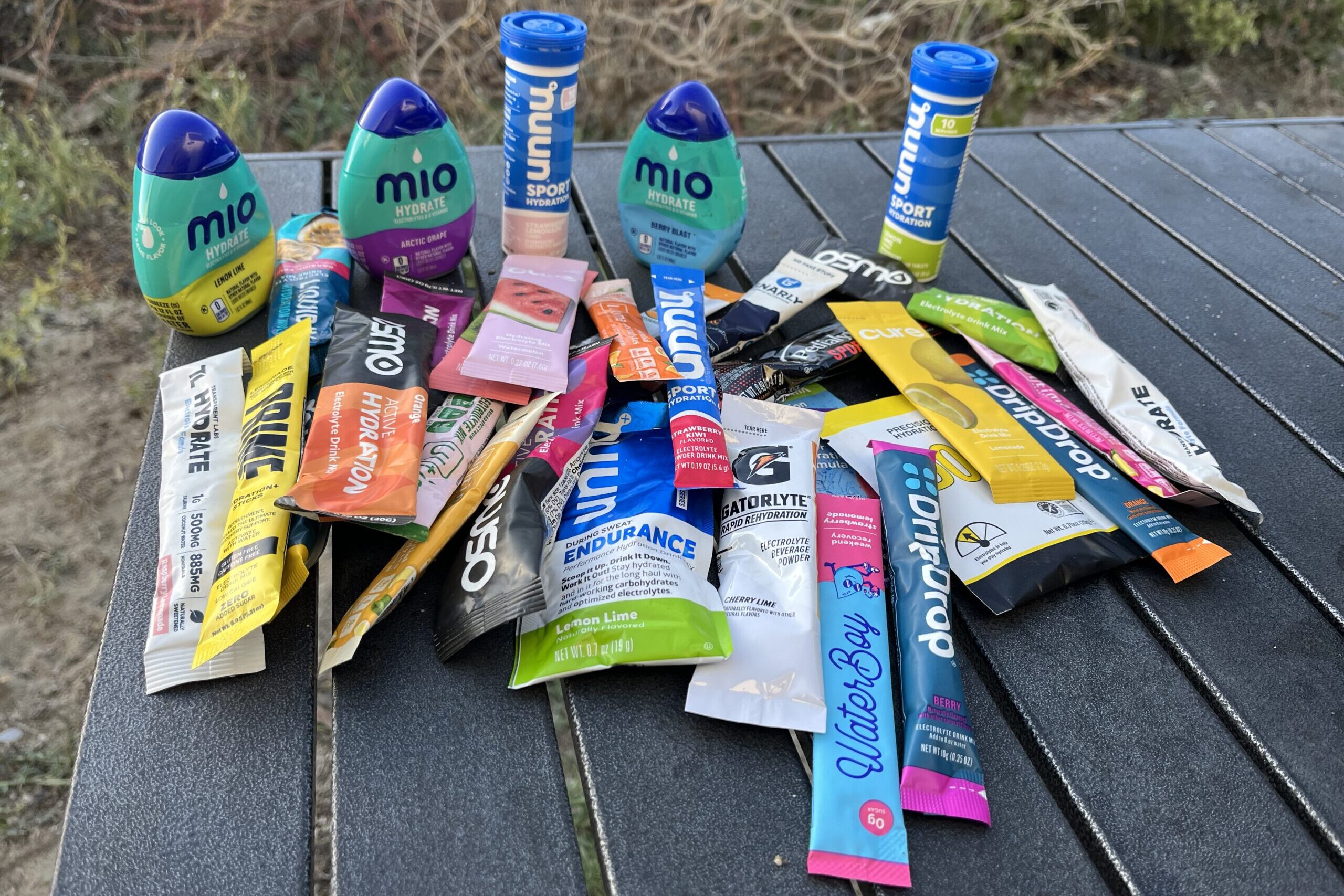
Hydration mixes can help replenish salts and provide energy-boosting nutrients to keep you going strong. From Southern California to humid Louisiana to arid Baja California, we’ve been sipping on hydration powders for hiking and backpacking for more than 50,000 miles. In this guide, we evaluate them for taste, solubility, performance, and side effects.
Our lead gear analyst is a certified sports nutrition coach, but it isn’t just her word in this guide. We consulted with registered dietitians to analyze the product labels and determine the benefits and drawbacks of each product based on its electrolyte balance, carbohydrate content, and third-party testing.
From brands like Liquid IV, Mio, Nuun, Skratch Labs, and more, we’ve researched dozens of mixes and tested the 19 most promising to determine the best of the best.
And for more info, check out some of our other popular gear guides:
Quick Picks for Hydration Mixes
Check out this quick list of our favorite hydration mixes, or continue scrolling to see our full list with in-depth reviews.
Best Hydration Mix Overall: Liquid I.V. Hydration Multiplier ($1.56/serving)
Most Compelling Science-Based Formula: DripDrop ORS ($1.12/serving)
Best Fizzy Tablets: Nuun Sport Tablets ($0.75/serving)
Electrolyte Drops with Excellent Solubility: Mio Hydrate ($0.57/serving)
Best Formula With Magnesium: Gnarly Sports Nutrition Hydrate ($0.75/serving)
Thoroughly Independently Tested: Transparent Labs Hydrate ($1/serving)
Most Soluble Electrolyte Powder: Gatorlyte ($0.89/serving)
Trail Running Runner-Up: Nuun Endurance ($1.25/serving)
Best Low-Sodium Hydration Powder: Ultima Replenisher ($0.49/serving)
Best High-Potassium Option: Hydrant Fast-Acting Electrolyte Powder ($0.66/serving)
Hydration Mix with the Boldest Flavors: Cure Electrolytes ($1.67/serving)
Great for High-Intensity Exercise: VitaLyte ($0.57/serving)
Budget-Friendly Hydration Mix: Dr. Price’s Electrolyte Mix ($0.46/serving)
Great Hydration Mix for Trail Running: Precision Hydration PH500 ($0.79/serving)
Best Vegan Plant-Based Electrolyte Powder: Vega Sport Hydration ($0.88/serving)
Includes B Vitamins: Osmo Active Hydration ($1.55/serving)
High-Sodium Option for Those Who Sweat A Lot: LMNT ($1.67/serving)
Best High-Carb for Fuel Option: Tailwind Endurance Fuel ($0.80/serving)
Best Hydration Powder with Real Fruit: Skratch Labs Hydration Sport Powder ($1.79/serving)
Affordable Electrolyte Powder with Light, Tasty Flavors: Gatorade Thirst Quencher ($0.89/serving)
What’s new
We’ve tested more than 10 new hydration electrolyte powders and added them to this guide.
- Liquid I.V. Hydration Multiplier is now our top overall pick, thanks to its all-around versatile formula with ample sodium and carbs, and reasonable pricing.
- Our tester consulted with registered dietitians to analyze the nutrient content of each new product and how it affects hydration.
Hydration Mix Overall Testing Scores
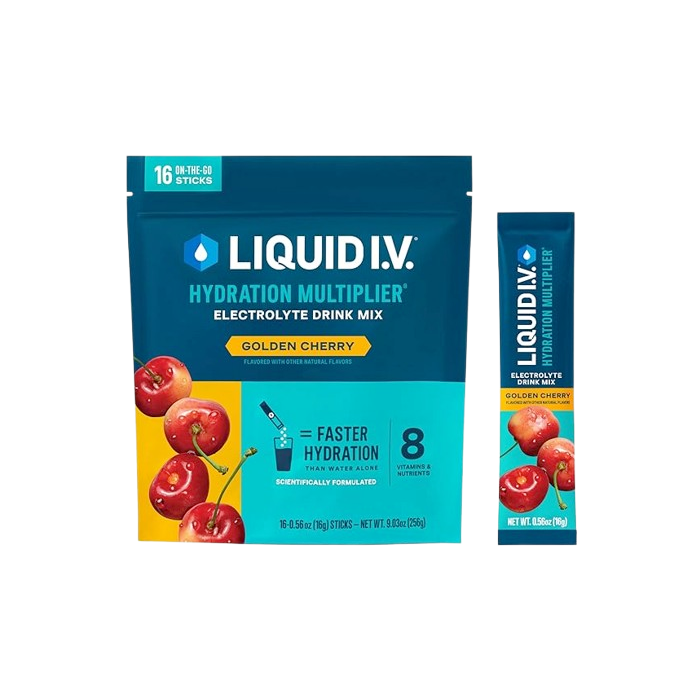
Liquid I.V. Hydration Multiplier
Best Hydration Mix Overall
CleverHiker Rating: 4.8/5.0
Cost/Serving: $1.56
Sodium (per serving): 560mg
Potassium (per serving): 370mg
Sugar (per serving): 11g
Sugar Content: 4.5
Pros
- More than a dozen flavors to choose from
- Contains sugar to assist with electrolyte absorption
- Available at many grocery stores
- Dissolves exceptionally well when stirred and shaken
- Individual sachets are easy to pack
Cons
- Some flavors taste artificial
- Slight variation in electrolyte content among flavors
Liquid I.V. Hydration Multiplier is a classic and a constant in the hydration powder arena. Its original (lemon lime) formula includes 560 milligrams of sodium and 370 milligrams of potassium, so it doesn’t quite fall within the dietitian-recommended range. There is slight variation in the sodium-to-potassium ratio among flavors. For instance, our tester currently has a box of the newer Passion Fruit flavor, which has 520 milligrams of sodium and 370 milligrams of potassium. It’s not a big deal, just something to be aware of if you’re trying to dial in your sports nutrition.
Liquid I.V. does not contain additional electrolytes like magnesium and calcium. The original formula contains 13 grams of carbs, 11 of which are sugar. When mixed with 16 ounces of water as directed, that’s a carb solution of 2.74%. That’s low if you’re looking for energy, but spot-on if you only want to support the electrolyte absorption process to speed up rehydration. Liquid I.V. dissolves well.
In fact, it’s one of the most soluble hydration powders we’ve tried, and we keep returning to it largely for that reason. It doesn’t settle in the bottom of bottles, and there are never chunks or flecks in the water. Most of the flavors taste good, though some taste a bit artificial, like golden cherry. Our favorites are the original lemon lime, passionfruit, and strawberry.
In total, you can choose from 16 flavors or get a variety pack to see which ones you like. Liquid I.V. Hydration Multiplier is not third-party tested, but it is sold as a food, so it must adhere to food guidelines as put forth by the FDA. These packets are larger than some, but not so large that packing would be a concern in most cases. The serving size is 16 grams, which is about the middle of the line as far as weight goes among these powders.
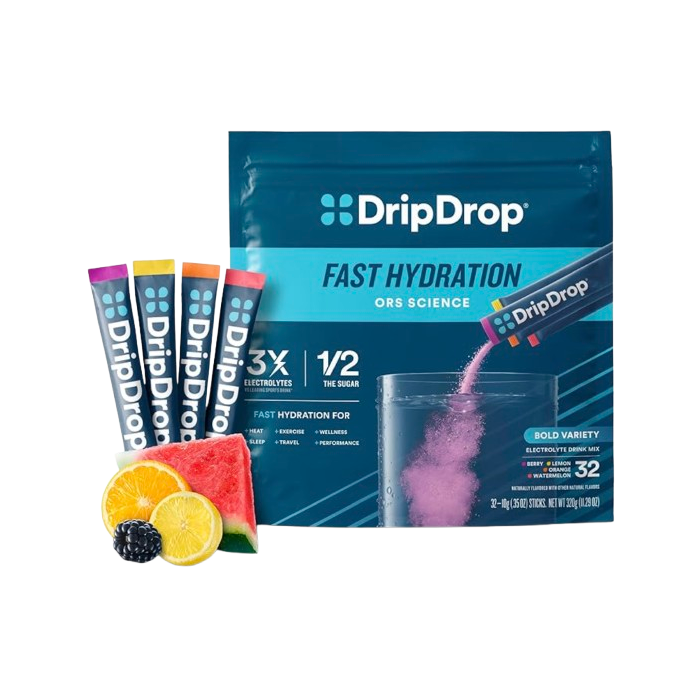
DripDrop ORS Science
Most Compelling Science-Based Formula
CleverHiker Rating: 4.7/5.0
Cost/Serving: $1.12
Sodium (per serving): 330mg
Potassium (per serving): 180mg
Sugar (per serving): 7g
Pros
- Based on the World Health Organization’s rehydration formula
- Dissolves well
- Sugar content speeds up nutrient absorption
- Several flavors to choose from
Cons
- Not third-party tested
- Some flavors taste really salty
DripDrop ORS Science is an oral rehydration salt solution (ORS) developed in line with the World Health Organization (WHO). An effective ORS, according to WHO guidelines, has 75 mmol/L sodium, 65 mmol/L chloride, 75 mmol/L glucose, 20 mmol/L potassium, and 10 mmol/L citrate. DripDrop’s formula is citrate-based, and while the website doesn’t disclose the specific mmol/L quantities of those stated ingredients, DripDrop does contain an effective dose of sodium, potassium, and glucose: 360 milligrams, 180 milligrams, and 7 grams, respectively.
When mixed with 8 ounces of water as directed, the carbohydrate solution is 3.8 percent. This isn’t a hydration powder that you can rely on for fuel during exercise (it only has 35 calories per serving), but it will absolutely support fast rehydration. We have used DripDrop since 2020, and we’ve never been disappointed in the taste or texture. It dissolves well, leaving little to no residue. We also haven’t had an issue with chunks or flecks in the water. We find the flavors to be pretty spot on for the name (that is, berry tastes like mixed berries), except grape, but we can’t fault DripDrop for that more than anyone else – it just takes like artificial grape.
DripDrop is not third-party tested for contaminants and substances that are banned in sports, so it scored low in this category. DripDrop states that the powder is Kosher, gluten-free, dairy-free, vegan, soy-free, and non-GMO, but does not state whether it is independently certified to be free from those things. The stick packs are some of the smallest, making them excellent for shoving into a crowded hiking pack.
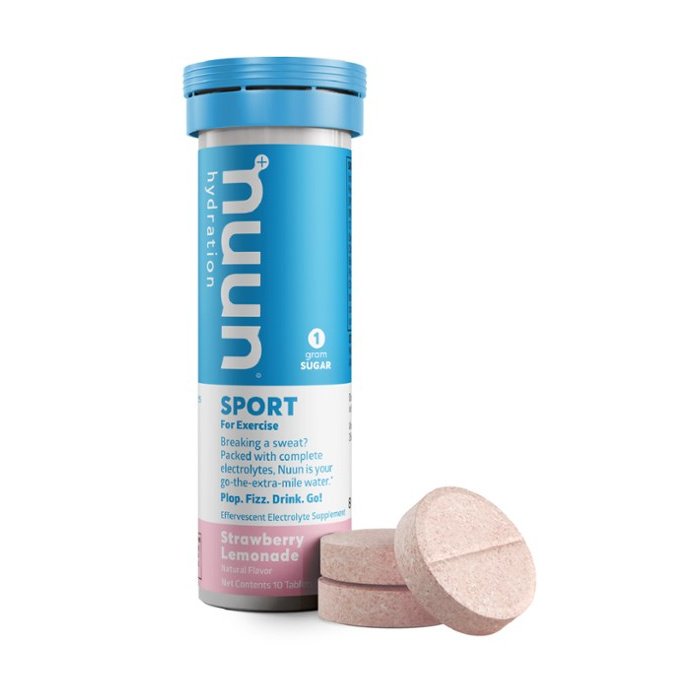
Nuun Sport Hydration Tablets
Best Fizzy Hydration Tablets
CleverHiker Rating: 4.7/5.0
Cost/Serving: $0.75
Sodium (per serving): 300mg
Potassium (per serving): 150mg
Sugar (per serving): 1g
Pros
- Makes fizzy, refreshing drink
- Easy to pack for hiking
- Large variety of flavors
- Small amount of sugar for nutrient absorption
- Available at many grocery & outdoor stores
- Packaging cuts down on microtrash
Cons
- Size of tablets doesn't work with all bottles (ex. Smartwater)
- Packaging is a little heavier/bulkier than others
- Takes a while for tablets to dissolve
- Not enough carb content to rely on for fuel
Nuun Sport Hydration Tablets are so refreshing thanks to the fizziness, and it almost feels like drinking a fruity soda. They have an optimal 2:1 sodium-to-potassium ratio with 300 milligrams of sodium and 150 milligrams of potassium. They also contain small amounts of calcium, magnesium, and chloride.
Nuun Sport tablets are low in carbs, with just 4 grams per serving. When mixed with 16 fluid ounces of water, the carb solution is not even 1 percent, so this definitely isn’t the right choice for a fuel-providing hydration powder.
However, it’s great if you’re getting carbs from other sources or exercising for less than two hours. Solubility is not even a little bit of a concern with these tablets. They’re effervescent, so they dissolve in your water like an Alka-Seltzer tablet. You won’t experience any settling, chunks, or residue—just fizzy goodness. In 16 ounces of water, the flavors taste mild, but not bland. We sometimes mix it with 8 ounces of water for a stronger taste.
As for flavor selection, you have eight to choose from. Our favorites are tri-berry and orange. The tablets are certified vegan, kosher, gluten-free, and non-GMO, but there is no independent verification from a vetting agency such as the NSF for impurities or banned substances. These might just be the most packable hydration products ever. You can bring 10 servings for a net weight of just 55 grams, and the tube is so small it can fit into the tiniest of pack compartments. Plus, the tube is a hard plastic with a very secure lid, so there’s no risk of puncturing the packaging and losing your precious electrolytes.
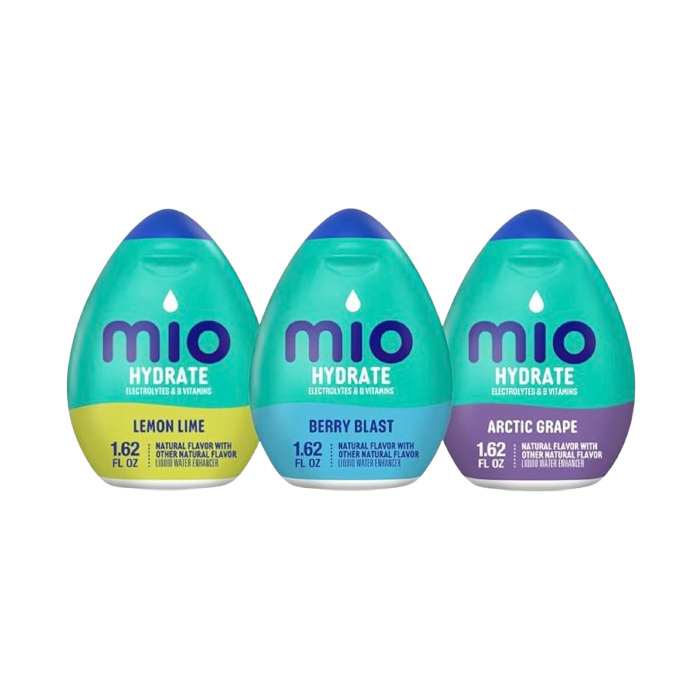
Mio Hydrate
Electrolyte Drops with Excellent Solubility
CleverHiker Rating: 4.6/5.0
Cost/Serving: $0.57
Sodium (per serving): 115mg
Potassium (per serving): 60mg
Sugar (per serving): 0g
Pros
- Inexpensive
- Incredible solubility
- Good option for low-activity days
- Great for people with lower sodium requirements
- Lightweight & easy to pack
Cons
- Hard to find in stores
- Tastes pretty bland
Mio Hydrate is lower in electrolytes with 115 milligrams of sodium and 60 milligrams of potassium per serving. Just because it is lower in these nutrients does not mean it’s worse than other products—sometimes, less is more. We don’t always need 500 or more milligrams of sodium per serving of fluid, even when exercising.
It’s a great option for individuals with lower sodium needs or those who don’t sweat heavily. It’s a nice option for colder months, too, when you lose less sweat. Mio Hydrate contains just 1 gram of carbohydrates and no sugar, so it’s also a nice option for lighter activities or a flavor boost on off days when you don’t need as much sugar or sodium.
We tried three Mio Hydrate flavors and, unfortunately, found them all to be quite lackluster. You really have to use a lot of the drops to get a robust flavor; when mixed as directed with 12 ounces of water, the flavor is barely there. From a solubility standpoint, however, Mio beats out the competition without a doubt. It’s already liquid! You’ll never have any chunks floating around, nor does this product settle in water or leave residue on your bottle.
Mio is not third-party tested by any agency, but it does have a nutrition label (not a supplements label), meaning it is regulated as a food by the FDA so it must adhere to stricter regulations than supplements. It couldn’t be easier to pack a bottle of Mio Hydrate, and it’s arguably easier than planning out how many stick packs of a powder you’ll need. You get to take multiple servings of electrolytes with the weight of just 1.62 liters of fluid (plus the negligible weight of the container). One thing to be aware of, though, is that the cap could pop open in your pack, and significant elevation changes may cause the bottle to inflate.
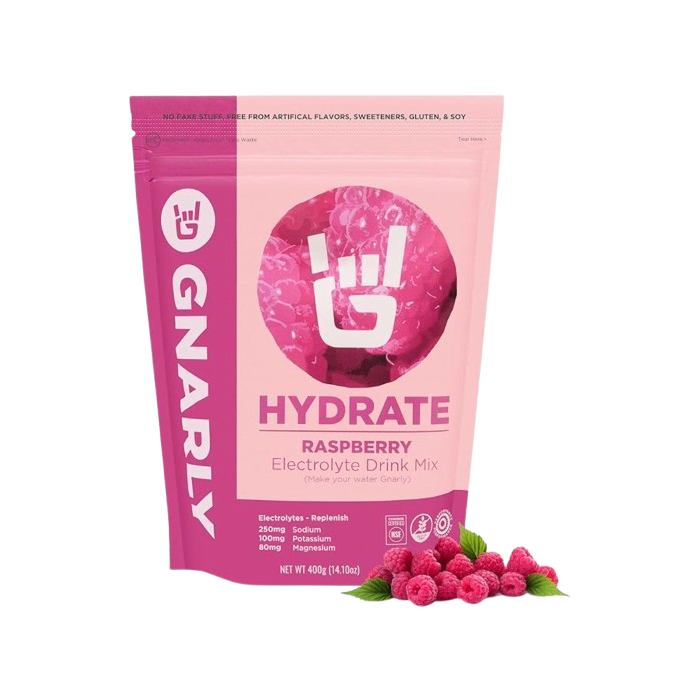
Gnarly Sports Nutrition Hydrate
Best Formula With Magnesium
CleverHiker Rating: 4.5/5.0
Cost/Serving: $0.75
Sodium (per serving): 250mg
Potassium (per serving): 100mg
Sugar (per serving): 4g
Pros
- Uses organic cane sugar & natural flavorings
- Contains 80 mg of magnesium
- Third-party tested (but only in bulk pouches)
- Sugar content helps with electrolyte absorption
Cons
- Does not contain sufficient carbs to use as food
- Solubility isn’t the best
Gnarly Sports Nutrition is formulated with 250 milligrams and 100 milligrams of potassium, putting it squarely in the category of moderate hydration powders. It’s a great choice for moderate trail days, as well as for a hydration boost on cold-weather days. Gnarly has 7 total grams of carbs, 4 grams of which are sugar. This makes the carb solution pretty low, but still helpful for the absorption of electrolytes during activity. It’s certainly not enough to rely on for energy, so make sure to eat plenty of carbohydrate-rich foods during hiking if Gnarly is your hydration powder of choice.
This powder is available in five flavors: ruby red grapefruit, orange pineapple, raspberry, lemonade, and salted margarita, which has extra sodium. Solubility-wise, we have some complaints about Gnarly Sports Nutrition Hydrate powder. When mixed in a shaker bottle, it dissolves okay, but quite a bit of the powder settles in the bottom. When we mixed it with a spoon in a glass, we were left with several chunks in the bottom of the glass after drinking all of the fluid.
Taste-wise, we love the raspberry flavor, though some may find it too sweet. This hydration powder is NSF Content Certified in all flavors, with the orange pineapple flavor also holding the NSF Informed Sport certification, but only in the bulk pouches, not the individual packets.
Gnarly Sports Nutrition hydration powder packets are an average size, and definitely small enough to pack several of them for an extended backpacking trip with no space concerns. The packets are durable, too, which we found out after discovering smashed (yet perfectly intact) servings at the bottom of a pack many weeks after the testing period.
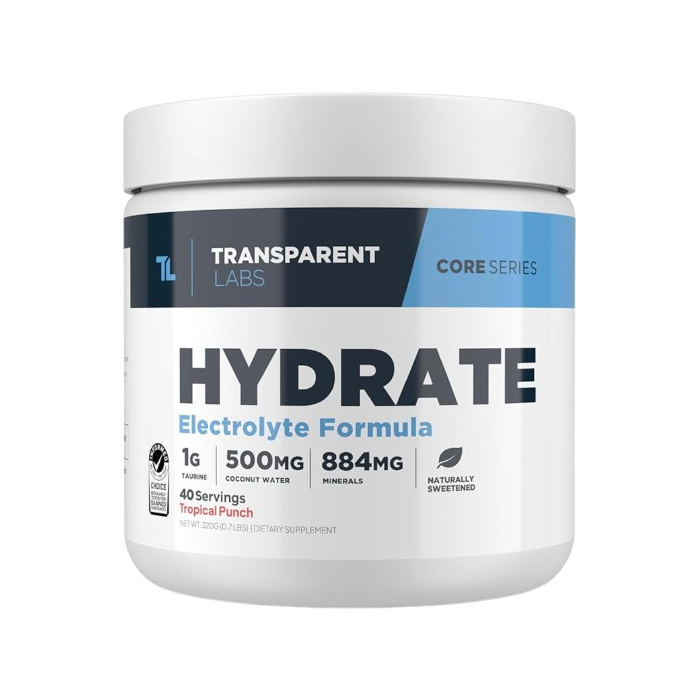
Transparent Labs Hydrate
Thoroughly Independently Tested
CleverHiker Rating: 4.5/5.0
Cost/Serving: $1.00
Sodium (per serving): 500mg
Potassium (per serving): 250mg
Sugar (per serving): 0g
Pros
- Optimal electrolyte balance
- Thoroughly third-party tested
- Contains iron & taurine
- Reasonably priced
Cons
- No sugar to support rapid absorption
- Solubility isn’t the best
- Has a stevia aftertaste
With 500 milligrams of sodium and 250 milligrams of potassium, Transparent Labs Hydrate nails the RD-recommended 2:1 sodium-to-potassium ratio. It also contains 1 milligram of iron, 50 milligrams of magnesium, and 1,000 milligrams of taurine. Iron helps deliver oxygen from the lungs to the rest of the body via hemoglobin, a critical component of exercise performance. Taurine helps balance fluids, salts, and minerals in the body and is thought to support nervous system control, too. It’s a thoughtful formula, though not necessary, so don’t feel like you’re missing anything by taking a powder without those added ingredients.
This electrolyte powder is sugar-free and contains one gram of carbohydrates. Make sure you’re consuming a snack with simple carbohydrates (sugar) to support nutrient absorption.
We find Transparent Labs Hydrate to be on the low end of average when it comes to solubility. Our tester definitely noticed some floating particles, and when she tried mixing it with a spoon (not a shaker bottle) a lot settled in the bottom of the cup. This could be because Transparent Labs stays away from common ingredients used as emulsifiers and other texture agents that create a smoother solution. We tried the raspberry lemon flavor, which is good but does leave a bit of a stevia aftertaste. There is only one other flavor to choose from: peach mango. Our lead analyst has had other Transparent Labs supplements in that flavor, and the same was true about the stevia.
Transparent Labs Hydrate is Informed Choice Certified, and you can find certificates of analysis for some flavors on the Transparent Labs website (you’ll need your batch number).
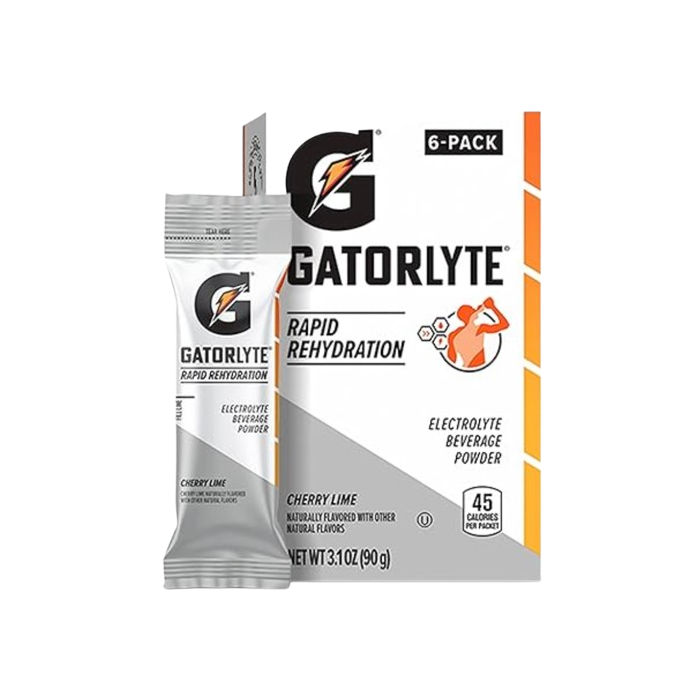
Gatorlyte
Most Soluble Electrolyte Powder
CleverHiker Rating: 4.5/5.0
Cost/Serving: $0.89
Sodium (per serving): 420mg
Potassium (per serving): 300mg
Sugar (per serving): 10g
Pros
- Several flavors to choose from
- Budget-friendly price per serving
- Specifically designed for quick absorption
- Sugar-free flavors available
- Great solubility
Cons
- Contains corn syrup
- Sugar content is not quite sufficient to use as fuel source
Gatorlyte is a newer offering from Gatorade and contains 420 milligrams of sodium, 300 milligrams of potassium, and 100 milligrams of calcium. The 420-milligram serving of sodium is moderately high, so it’s great for higher-intensity or hotter days.
Unlike the original Gatorade Thirst Quencher powder which contains 21 grams of carbohydrates, Gatorlyte contains only 12 grams. This makes it a better choice for people who plan to get more of their energy from food, or who simply don’t want or need 21 grams of sugar. The Gatorlyte carb solution, when mixed as directed in 16.9 ounces of water, is 2.4%.
Gatorlyte mixes extremely well thanks to the food additive silicon dioxide. This additive is found naturally in plants and drinking water, and research has thus far demonstrated it is safe for oral consumption. It eliminates clumping and caking, which is how the powder dissolves into a nearly clear solution with no flecks or chunks. We’ve tried a few Gatorlyte flavors, and cherry lime is our favorite. We haven’t been disappointed by any of the flavors we’ve tried, and we don’t detect the artificial aftertaste that often comes with food dyes. Other flavors to choose from include glacier freeze, mixed berry, orange, strawberry kiwi, and lime cucumber.
There are some sugar-free flavors available, too: lemon lime, strawberry kiwi, and fruit punch. Gatorlyte has a nutrition facts label, not a supplement facts label, meaning it’s regulated as a food and not a supplement. Therefore, third-party testing isn’t as much of a concern. The individual packets are medium-sized and easy to pack. The sachets have a very plasticky exterior, so you’re unlikely to experience any unwanted ripping or water leaking into the packets.
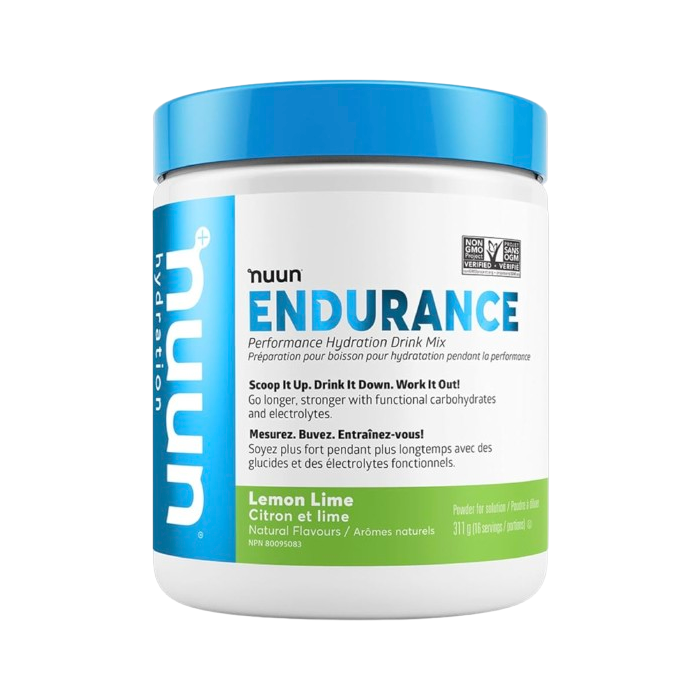
Nuun Endurance
Trail Running Runner-Up
CleverHiker Rating: 4.4/5.0
Cost/Serving: $1.25
Sodium (per serving): 380mg
Potassium (per serving): 200mg
Sugar (per serving): 15g
Pros
- Well-rounded blend of key electrolytes
- Easy to mix and adjust the concentration to suit individual needs
- Sweetened with natural ingredients
- 15g carbs per serving supports endurance
- Third-party tested
Cons
- Limited flavor options
- Leaves residue in bottom of bottles & cups
- May not have enough sodium for hot weather trail days
With 380 milligrams of sodium and 200 milligrams of potassium, Nuun Endurance has a primary electrolyte ratio of 19:10, or nearly 2:1. The sodium content is pretty moderate and suitable for most people during most activities; extended exercise in very hot weather might require more for some hikers. This has 16 grams of carbs, 15 of which are sugar, in a 19-gram serving size.
When mixed with 16 fluid ounces of water as directed, you’ll have a carbohydrate solution of about 3 percent. For particularly intense trails or in hot weather, this can be taken in addition to solid food, or you can use it as your main fuel source for shorter adventures.
Nuun Endurance is only available in two flavors: lemon lime and strawberry lemonade, which contains a modest amount of caffeine (25 milligrams per serving—not enough to touch a regular coffee drinker like our tester). We think the flavor is just okay. It tastes like your average powdered lemon-lime drink; not too sweet, not too sour. It dissolves mostly well, though it leaves a bit of residue at the bottom of a cup or bottle if you let it sit for more than a few minutes. Not a problem if you’re chugging, but a bit irksome if you’re sipping.
Nuun Endurance holds the NSF Informed Sport certification. This product is also certified vegan, non-GMO, Kosher, and gluten-free. These are among the most durable of the sachets we tested, but they are larger than most. Some hikers might find the size annoying, but we don’t think it’ll cause an issue in most cases.
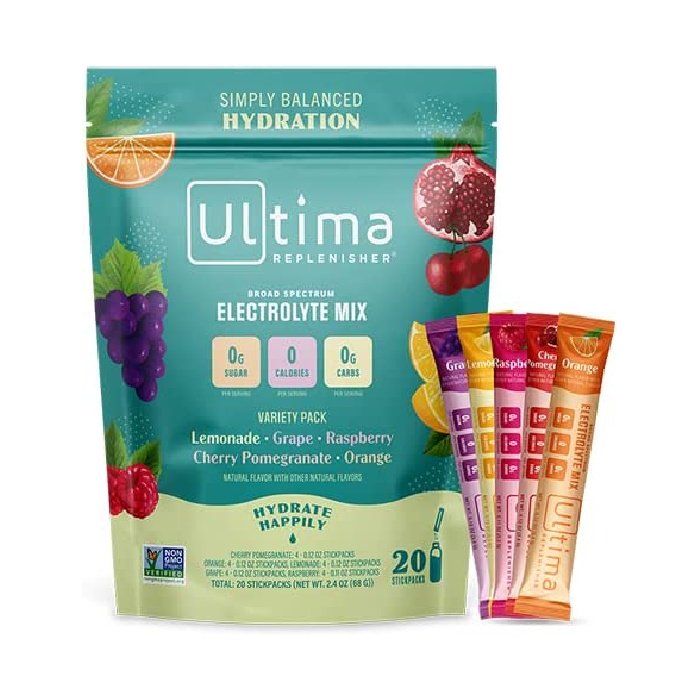
Ultima Replenisher
Good Low-Sodium Hydration Mix
CleverHiker Rating: 4.3/5.0
Cost/Serving: $0.49
Sodium (per serving): 55mg
Potassium (per serving): 250mg
Sugar (per serving): 0g
Pros
- Low sodium content is great for off days
- Affordable
- High potassium content can help prevent cramps
- 6 additional electrolytes aside from sodium & potassium
- Many flavor options
- Variety packs available
Cons
- Sodium content is not sufficient for rapid rehydration
- Sugar-free formula doesn’t assist with sodium absorption
Ultima Replenisher electrolyte powder is very low in sodium with just 55 milligrams per serving. While this is probably too little for rehydration in most hiking scenarios for most people, it’s a worthy consideration for those who are trying to watch their sodium intake but want other nutrients (and some flavor) in their water.
It contains 250 milligrams of sodium, bringing it close to a 1:5 ratio of sodium to potassium. The formula contains more types of electrolytes than most other formulas, including calcium, magnesium, chloride, zinc, manganese, and phosphorus.
This powder is sugar-free. Between that and the low sodium content, it’s an excellent choice for low-activity days or inactive days when you need a boost of flavor to keep yourself hydrated. Ultima Replenisher dissolves well for the most part; better in a shaker bottle than in a glass, per usual. One thing we find interesting is that Ultima doesn’t specify a quantity of water to mix it with. You might need to do some experimenting to find what tastes best to you. We find that it tastes a bit bland if we use more than eight ounces of water.
Those prone to flavor fatigue will love that Ultima offers 16 flavors to choose from, plus several variety pack options. Our favorites include pink lemonade, orange, and strawberry margarita.
Ultima Replenisher is not third-party tested, but is sold as a food, so it is subject to meeting stricter regulatory requirements set forth by the FDA than powders sold as supplements. The packets are super tiny; a serving size is just 3.3 grams, which shows in the very low sodium content and zero sugar content. The stick packs are perfectly durable and easy to pack with no fear of them tearing open while hiking.
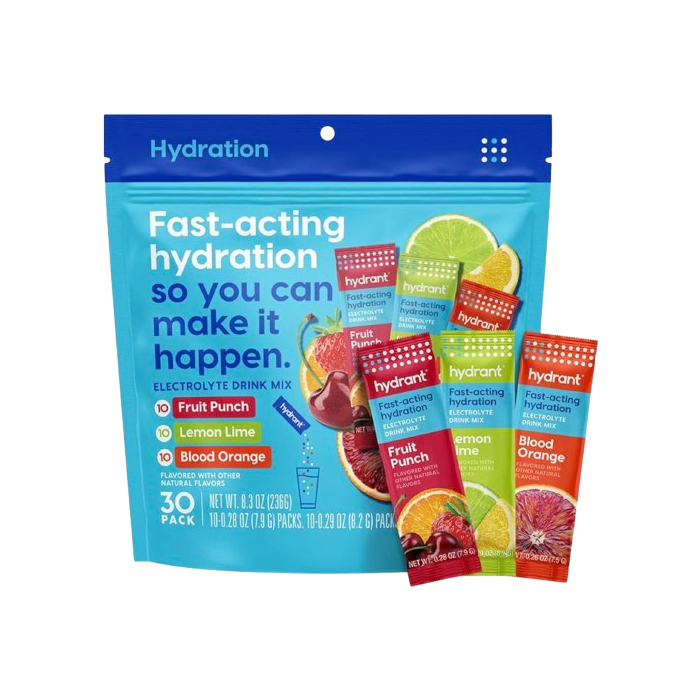
Hydrant Fast-Acting Electrolyte Powder
Best High-Potassium Option
CleverHiker Rating: 4.3/5.0
Cost/Serving: $0.66
Sodium (per serving): 520mg
Potassium (per serving): 403mg
Sugar (per serving): 0g
Pros
- High in potassium
- Less expensive
- Available in 9 flavors, plus unflavored
- Sugar-free formula is ideal for low-activity days
Cons
- No sugar to support nutrient absorption
- High in sodium for a sugar-free formula
Hydrant has 520 milligrams of sodium, so it’s a moderately rich formula and suitable for a wide range of people in a wide range of exercise settings. It also contains 403 milligrams of potassium, which is on the high end of all hydration powders we’ve tried. The ratio of sodium to potassium is closer than what you’ll find in most powders, which is not necessarily a bad thing and can be a good thing for people who are prone to muscle cramps or just find it difficult to meet the recommended intake of potassium through food alone.
Hydrant has magnesium (60 milligrams) and zinc (4 milligrams), two electrolytes shown to improve athletic performance through various pathways. It is sugar-free and sweetened with monk fruit extract. Since it doesn’t contain any sugar and only 1 gram of carbohydrate, it’s an option for hydrating on days when you aren’t active, for light hikes, or if you plan to get all of your carbs from solid food while also sipping on electrolytes.
The lemon lime flavor is pretty innocuous and tastes like your average lemon-lime-flavored drink – it’s not overly salty or sweet, which is nice. We noticed a couple of flecks after stirring it in a cup with a spoon, but when shaken in a bottle, it dissolves well. As for variety, Hydrant is available in nine flavors, plus an unflavored option.
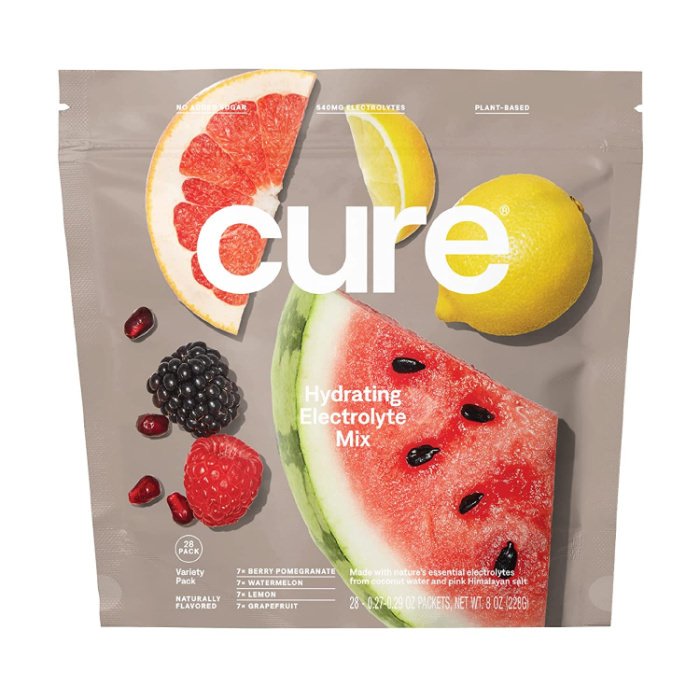
Cure Electrolytes
Hydration Mix with the Boldest Flavors
CleverHiker Rating: 4.3/5.0
Cost/Serving: $1.67
Sodium (per serving): 240mg
Potassium (per serving): 300-350mg
Sugar (per serving): 0g
Pros
- Delicious, bold flavors
- Excellent solubility
- Great electrolyte ratio for moderate activities
- No artificial flavors or sweeteners
- Small amount of sugar for nutrient absorption
Cons
- A bit expensive
- Not enough sugar to rely on for energy
- May not have enough sodium for very hot weather
For a bold taste, try Cure Electrolytes. It comes in nine flavors, and there are a couple of different variety pack options. We tried lemonade, strawberry kiwi, watermelon, and berrypomegranate. The latter is our favorite, but all are good: none taste too sweet, and we didn’t pick up on any stevia aftertaste, which is a big plus.
We also found Cure to dissolve well in various water temperatures via various methods. In fact, it’s one of few that dissolves almost completely with just a spoon in a glass. In a shaker bottle or Nalgene, it dissolves exceptionally well and there is no noticeable texture. The formula leaves a bit to be desired from a sports nutrition standpoint.
Cure electrolyte powder contains more potassium than sodium, which our tester, a sports nutrition coach, finds interesting. Cure claims the formula is based on the WHO’s ORS formulation, but the WHO states that the sodium content should be higher than potassium content. It does contain a small amount of sugar to aid absorption, which is in line with WHO guidelines.
It has 250 milligrams of sodium, so it’s suitable for moderately active individuals and exercising in moderate conditions. You may require more sodium for particularly intense activities or very hot, long days. Cure electrolyte powder is sweetened with both stevia extract and monk fruit extract. It is sugar-free, so be sure to consume a snack with sugar while you drink it to optimize electrolyte absorption.
The electrolyte powders are independently tested for heavy metals, including lead, mercury, arsenic, and cadmium. We love that the sachets lie flat and are relatively small, with one serving weighing 7.6 grams.
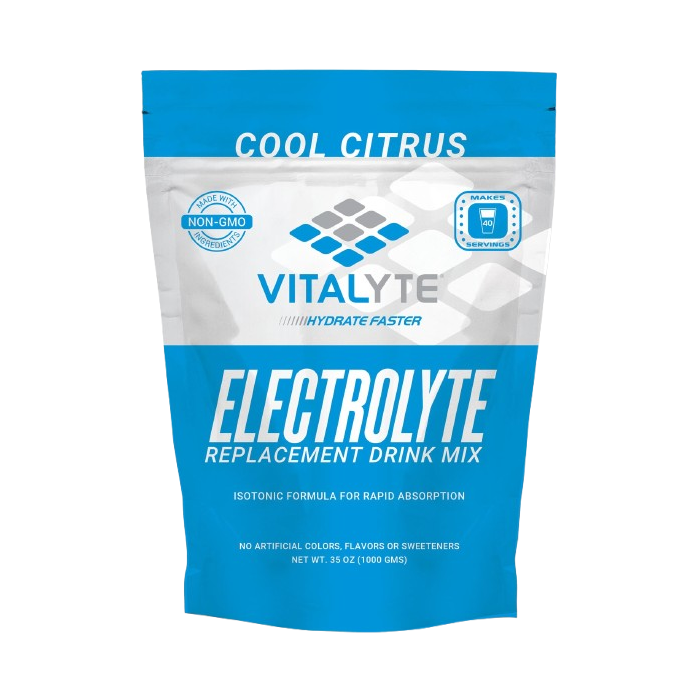
Vitalyte
Great Value for High-Intensity Exercise
CleverHiker Rating: 4.2/5.0
Cost/Serving: $0.57
Sodium (per serving): 135mg
Potassium (per serving): 193mg
Sugar (per serving): 21g
Pros
- Sufficient carbs to use as fuel source
- Very reasonably priced
- Good amount of calories per serving
- Good amount of calories per serving
Cons
- Slightly artificial taste
- Somewhat low in sodium
Interestingly, Vitalyte contains more potassium than sodium, with a ratio nearing 1:1 (135 milligrams of sodium to 193 milligrams of potassium). It contains trace, verging on negligible, amounts of magnesium (3 milligrams) and calcium (4 milligrams), along with some phosphorus (46 milligrams).
Because of the lower sodium content, it’s a good choice for active people who want energy (sugar) to support endurance but need to watch their salt intake. This formula is almost all carbs: Each serving contains 22 grams of carbohydrates, and the serving size is 25 grams in total. The recommended fluid amount is 16 ounces, which creates a carb solution of almost 5 percent, one of the highest carb concentrations on our list.
It’s a great choice for high-intensity activity, very prolonged activity (more than a couple of hours), and very hot days. We liked the taste of Vitalyte for the most part, though it tasted slightly artificial. Flavor options include orange, watermelon, lemon, grape, fruit punch, and cool citrus—a simple and classic collection that we appreciate.
When considering solubility, this powder falls right down the middle of the line. It dissolves mostly well, with a few flecks left here and there. Each sachet contains a 25-gram serving, so these are on the large side. They do contain 22 grams of carbohydrates, so they could count as a food item and not just as an electrolyte powder, depending on your needs. If you’re looking to save weight, you could bring Vitalyte packets in place of fresh or dried fruit.
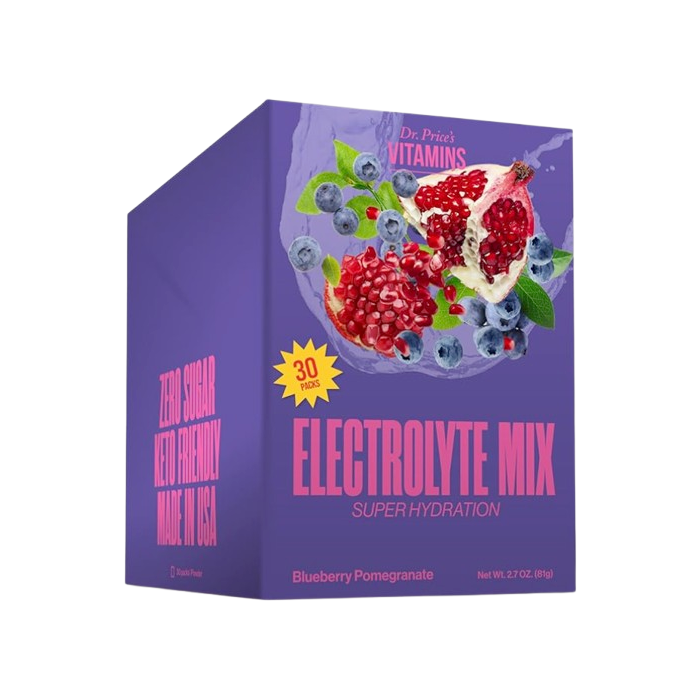
Dr. Price’s Electrolyte Mix
Budget-Friendly Hydration Mix
CleverHiker Rating: 4.2/5.0
Cost/Serving: $0.46
Sodium (per serving): 200mg
Potassium (per serving): 330mg
Sugar (per serving): 0g
Pros
- Very low cost per serving
- Contains 5 key electrolytes
- Includes micronutrient blend with additional minerals
- No added sugar
- Small serving sizes make for lightweight packets
Cons
- Not third-party tested
- Harder to pour into narrow-mouth bottles
- Some flavors leave a sticky feeling in your mouth
- Flavors taste almost bland
Dr. Price’s Electrolyte Mix contains 200 milligrams of sodium and 330 milligrams of potassium. The sodium content is sufficient for light activities and exercising in moderate weather, but you may need more for intense activities, hot days, or prolonged exercise. The brand claims that the formula is developed for fast absorption, but the formula is sugar-free, meaning it’s not in line with evidence-based best practices for optimizing electrolyte absorption.
Still, it’s a respectable budget-friendly pick. For less than 50 cents per serving, you’ll get a moderate dose of sodium and a high dose of potassium. This powder is sweetened with stevia, so it can be a good option for low-activity days when you need a hydration boost but don’t need the extra sugar. We tried lemon lime and blueberry pomegranate, and we find both to be quite mild, especially when mixed in the recommended 16 ounces of water.
The taste is much better with less water: We tried it with as little as 6 ounces per sachet. This product is marketed and sold as a supplement, but lacks any third-party verification, which we don’t love. The individual packets are small, and they are more square in shape than most of the others, which resemble tubes. They also only weigh 2.7 grams each. The packaging seems durable; it should not rip or tear in your pack.
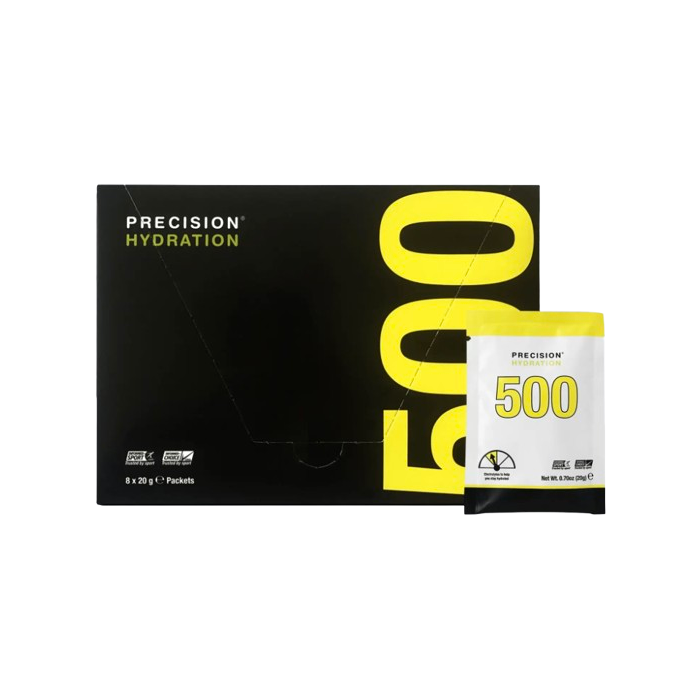
Precision Hydration 500
Best Hydration Mix for Trail Running
CleverHiker Rating: 4.5/5.0
Cost/Serving: $0.79
Sodium (per serving): 500mg
Potassium (per serving): 250mg
Sugar (per serving): 17g
Pros
- Optimal electrolyte ratio
- Sufficient carbs to support endurance
- Easily packable sachets
- Contains magnesium & calcium
- Third-party tested
Cons
- Only one flavor available
- Hard to find
Precision Hydration 500 has 500 milligrams of sodium and 250 milligrams of potassium. Designed for endurance athletes, the assumption is that a lot of sweat is being lost over prolonged periods of exercise. While 500 milligrams is on the high end for light activities, cold weather, and those who don’t sweat heavily, it’s definitely not excessive and probably has a place in the routine of most outdoor enthusiasts, depending on the specifics of their adventure.
PH 500 also includes a bit of calcium (48 milligrams) and magnesium (24 milligrams) which both play crucial roles in hydration and sport performance. It is moderately high in sugar (18 grams) for an electrolyte drink, but not so high when you consider the fact that many people use PH 500 as their main or only fuel source during endurance training and events. It’s unlikely that that would be the case for a hiker or backpacker, though.
One serving contains 20 grams of carbohydrates, which equates to a 3% carb solution when mixed with water as directed, so think of this as a support for your nutrition, not the only carb source, for long trail days. PH 500 dissolves exceptionally well: You’re unlikely to notice any substantial texture after shaking it up in water. There is only one flavor, which has a mild citrusy taste. It’s not bad, but it does get old after a while.
Our tester extensively used PH500 while training for a half-Ironman, and she started to get flavor fatigue pretty intensely near the end of her training block. If she’s only using it periodically for hiking, though, she doesn’t have a problem with it. Precision Hydration independently tests most of its products, including PH 500. This product specifically has two certifications: NSF Informed Choice and NSF Informed Sport, which we love.
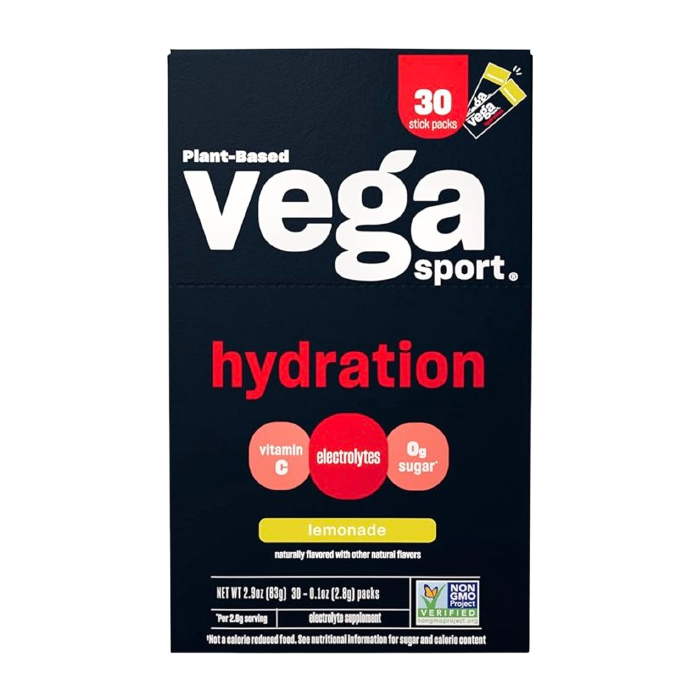
Vega Sport Hydration
Best Vegan Plant-Based Electrolyte Powder
CleverHiker Rating: 4.1/5.0
Cost/Serving: $0.88
Sodium (per serving): 250mg
Potassium (per serving): 130mg
Sugar (per serving): 2g
Pros
- Plant-based formula
- Less expensive
- Good for low-intensity days
- Tiny serving size is easy to pack
- Vega is a certified B corp
Cons
- Only two flavors
- Insufficient sodium for high-intensity activity or hot days
Vega Sport Hydration is a nice option for anyone who is explicitly looking for a vegan hydration powder. While electrolyte powders generally are vegan, the Vega Sport formula is explicitly plant-based.
It contains 250 milligrams of sodium, so it’s light on the electrolytes compared to some heavier-hitting options. Again, this doesn’t mean it’s bad. In fact, it’s a better choice for people who sweat lightly or are exercising in cold weather. The potassium content clocks in at 130 milligrams, and it has 20 milligrams of magnesium and 50 milligrams of calcium to support muscle contraction, fluid balance, and other important performance components.
Vega Sport Hydration is sugar-free and contains just 2 grams of carbs, so it’s not something to rely on for energy. However, it’s great for light activities, rehydrating on slower days, or for those who plan on getting sugar and carbs from other sources during heavy exercise. While we think the lemonade flavor is decent, it’s no lemonade from a neighborhood stand. (Then again, it’s not chock-full of sugar.) Other than lemonade, berry is the only other option.
In a shaker bottle, this powder mixes fine; in a glass, not so much. We were unable to achieve a fully mixed solution in a glass, stirring with a spoon. Vega Sport Hydrator is not third-party tested for impurities, but it is Non-GMO Project Verified and Vega is a certified B Corp.
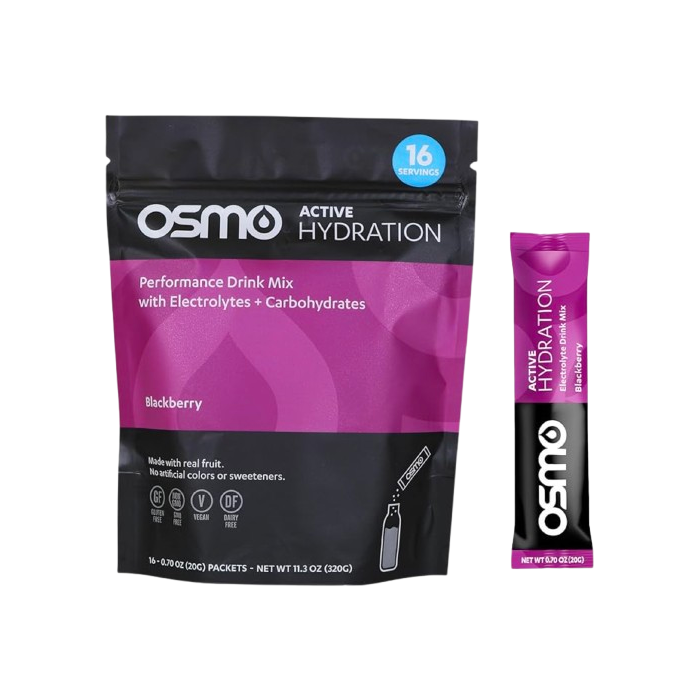
OSMO Active Hydration
Electrolyte Mix with B Vitamins
CleverHiker Rating: 4.1/5.0
Cost/Serving: $1.55
Sodium (per serving): 265mg
Potassium (per serving): 96mg
Sugar (per serving): 17g
Pros
- Includes B vitamins
- Flavored with real fruit
- Ample carb content to support endurance
- Sugar supports rapid electrolyte absorption
Cons
- Quite low in potassium
- On the pricey side
- Large serving size
Osmo Active Hydration has 260 milligrams of sodium and 96 milligrams of potassium, so it doesn’t quite fall within the dietitian-recommended ratio range, but it’s not so far off that we can’t recommend it. This formula contains 95 milligrams of calcium and 29 milligrams of magnesium, plus some vitamin C and several B vitamins.
Overall, the electrolyte concentration is moderate, making it a good choice for lighter activities and those who don’t tend to sweat much. Osmo Active Hydration contains 17 grams of sugar, with the full serving size being 20 grams. When mixed as directed with 20 ounces of water, it has a carb solution of about 2.9 percent.
It can help provide energy for exercise while avoiding gastrointestinal distress, though for very intense activities, you may need more fuel. For prolonged activities, like hiking and backpacking, consider eating while you sip. Available in four flavors (lemon lime, blackberry, blueberry pomegranate, and orange), Osmo has a rather robust taste, which we appreciate. It dissolves well in a shaker bottle or Nalgene, though as usual, struggles to fully mix in a glass when stirred.
Despite its high sugar content, we didn’t notice an excessive amount of residue on my bottle when we finished drinking, and it didn’t settle in the bottom, either. Osmo Active Hydration is not third-party tested. However, it is sold as a food, so it is governed by tighter regulations than supplements. The individual serving packets are somewhat large. The serving size is 20 grams, which adds up when you think about a multi-night trip, but remember that this formula can replace some heavier foods (like fruit, if you’re not concerned about fiber). This could save you weight in the long run.
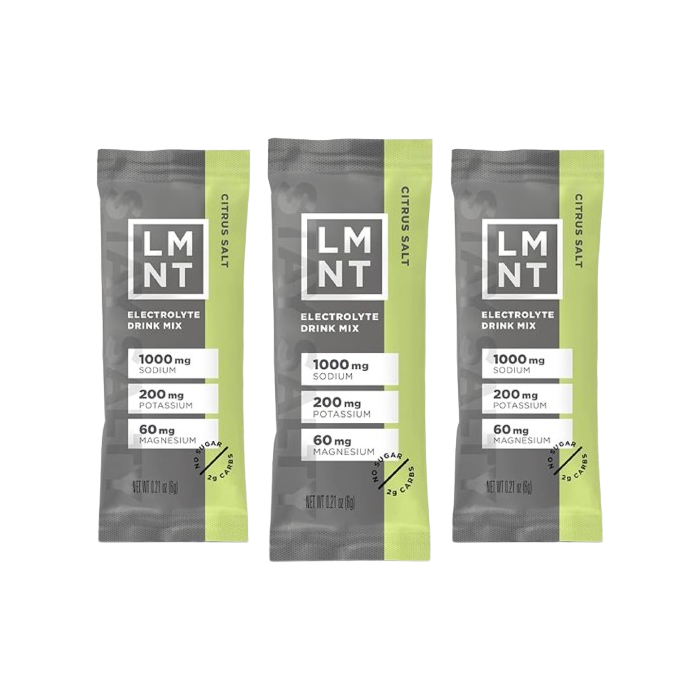
LMNT
High-Sodium Options for Those Who Sweat A Lot
CleverHiker Rating: 4.0/5.0
Cost/Serving: $1.67
Sodium (per serving): 1000mg
Potassium (per serving): 200mg
Sugar (per serving): 0g
Pros
- High sodium content caters to very heavy sweaters
- No artificial flavors, colors & fillers
- Sugar-free formula ideal for watching carb intake
- Great flavor variety
Cons
- Too high in sodium for most people
- All flavors taste very salty
- No glucose to support sodium absorption
LMNT contains 1,000 milligrams of sodium per serving, which, according to nutrition guidelines, is far too high for the average person. There is a use case for LMNT, of course, but expert input suggests it should be left to people who sweat very heavily, people who are exercising in very hot environments, and people who are exercising for extended periods of time (more than two hours) at a moderate to high intensity. It’s just overkill for most people and most exercise scenarios, including hiking, except in those stated exceptions. (There’s a reason you won’t find many–or any–other hydration powders with this much sodium).
LMNT contains 200 milligrams of potassium, which is in line with sports nutrition recommendations. It also contains magnesium to help with muscle function, among other things. LMNT is sugar-free, so there’s no glucose in the formula to assist with the absorption of the electrolytes. This makes the high sodium content further unjustified in our gear analyst’s opinion as a certified sports nutrition coach. It’s already high, and then there’s nothing added to help your body actually get it into the bloodstream.
Some may argue that LMNT is the ideal choice for rehydration if you find yourself severely dehydrated but something with a little sugar is better. All that said, it’s worth considering if you know that you need to replenish a large amount of sodium lost through sweat. As for taste and solubility, LMNT dissolves well, and no matter the flavor, it tastes incredibly salty (not a surprise given the formula). There are a lot of flavors to choose from if you like it: nine, including an unflavored option.
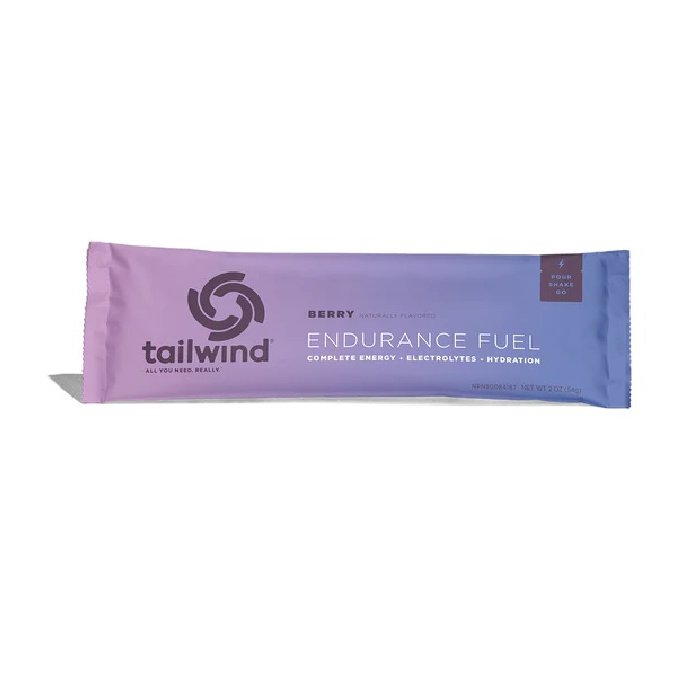
Tailwind Endurance Fuel
Best High-Carb for Fuel Option
CleverHiker Rating: 3.9/5.0
Cost/Serving: $0.80
Sodium (per serving): 310mg
Potassium (per serving): 90mg
Sugar (per serving): 25g
Pros
- Great for high-intensity or prolonged exercise
- Priced low for the nutrient density
- Caffeinated options
- No artificial colors/sweeteners
- Several flavor options
Cons
- Sachets are large (27g serving size)
- Requires more water than other options (20-24 oz.)
- Cola flavor tastes like flat Coke
- Harder to pour into narrow-mouth bottles
Tailwind Endurance Fuel contains 310 milligrams of sodium, 90 milligrams of potassium, 27 milligrams of calcium, and 12 milligrams of magnesium. The quantities of the latter two are negligible, but the numbers for sodium and potassium are very respectable. The potassium content is slightly low compared to the sodium content (a simplified ratio of 31:9), but that is not a bad thing for extended activity, which is what Tailwind is intended for.
Don’t be scared when you read the label and find out that this powder contains 25 grams of sugar in a single serving: Tailwind Endurance Fuel is meant to be used as a fuel source during extended periods of activity, replacing food altogether or allowing you to eat lesser quantities of solid food. It’s helpful for individuals who lose their appetite with exercise, as it allows them to drink their much-needed calories. Plus, when mixed as directed with 20 to 24 fluid ounces of water, the carbohydrate solution is still only about 3.5 percent on the low end or 4.2 percent on the high end.
For so much powder (27 grams), we’re impressed by its solubility. Flavor-wise, all Tailwind flavors taste very sweet. They essentially create a sugar cocktail, after all. Our tester has tried every flavor that comes in the variety pack and liked all of them well enough except the Cola flavor. Tailwind Endurance Fuel is not third-party tested, but it is sold as a food, not a supplement. The serving size is 27 grams, and the packets are so bulky you’d definitely need to plan for them if you were taking multiple on a trip. That said, they’re a solid energy source, so they could potentially replace heavier foods and you could come out net positive as far as weight goes.
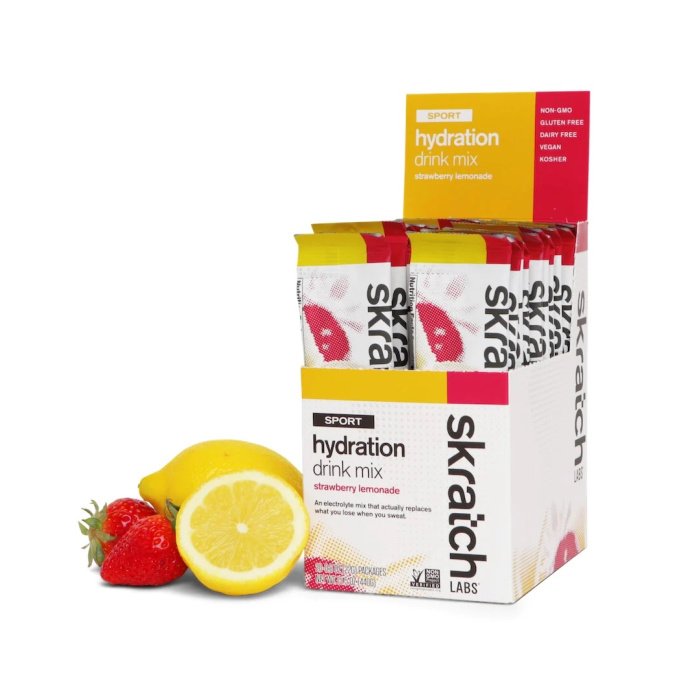
Skratch Labs Hydration Sport Powder
Best Electrolyte Mix with Real Fruit
CleverHiker Rating: 3.8/5.0
Cost/Serving: $1.79
Sodium (per serving): 400mg
Potassium (per serving): 50mg
Sugar (per serving): 19g
Pros
- High in sodium & carbs to support prolonged activity
- Flavored with real fruit
- No artificial colors/flavors/sweeteners
- Can replace solid foods in some cases
Cons
- Tastes syrupy when mixed with less than 16 oz. water
- Packets are larger in size than most options
- Somewhat expensive per serving
Skratch Labs Hydration Sport Powder provides ample sodium (370 milligrams per serving) but lacks in potassium (just 35 milligrams per serving). It contains small amounts of magnesium and calcium in each serving, too. With such a low potassium content, it’s ideal for individuals who already get sufficient potassium from foods.
With 17 grams of carbohydrates in a 22 gram serving, intended to be mixed into 12 to 16 fluid ounces of water, the carb solution comes out to about 4.7% on the high end and about 3.6% on the low end. It will provide energy, but this solution is low enough to prevent GI distress in most people, even during heavy exercise. You have seven flavors to choose from, and all of them are quite sweet.
We’ve tried pineapple, fruit punch, and strawberry lemonade. We love that they’re flavored with real fruit instead of artificial flavoring. When shaken with 16 ounces of water in a bottle, the powder dissolves fine; impressively, even, for a 22-gram serving size. Skratch says you can use as little as 12 ounces of water, but when we tried that, we thought it was far too sweet (almost syrupy).
Skratch hydration packets are on the larger size, since the serving size is 22 grams. While this sounds big on the surface for hiking, you can use Skratch to replace some whole foods (like fruit, for instance) on long trips, when weight is a priority.
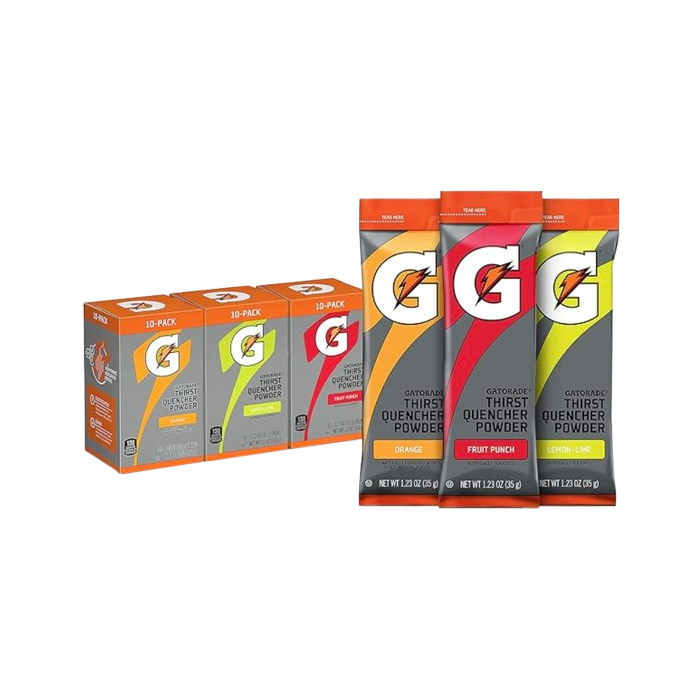
Gatorade Thirst Quencher
Affordable Electrolyte Powder with Light, Tasty Flavors
CleverHiker Rating: 3.8/5.0
Cost/Serving: $0.89
Sodium (per serving): 230mg
Potassium (per serving): 70mg
Sugar (per serving): 32g
Pros
- Affordable
- Available at most grocery stores
Cons
- Not as many electrolytes
- High sugar content (32g)
- Artificial colors/flavors
We’ve been drinking Gatorade Thirst Quencher since way back in our high school track days. We loved it back then, and we still use it on trail now. While they’re not a go-to for us because of the high sugar content and lack of essential minerals, like magnesium and calcium, we still like them for their affordability and availability at most grocery stores. And while the flavors are artificial, we still think they taste good and are okay to have in moderation.
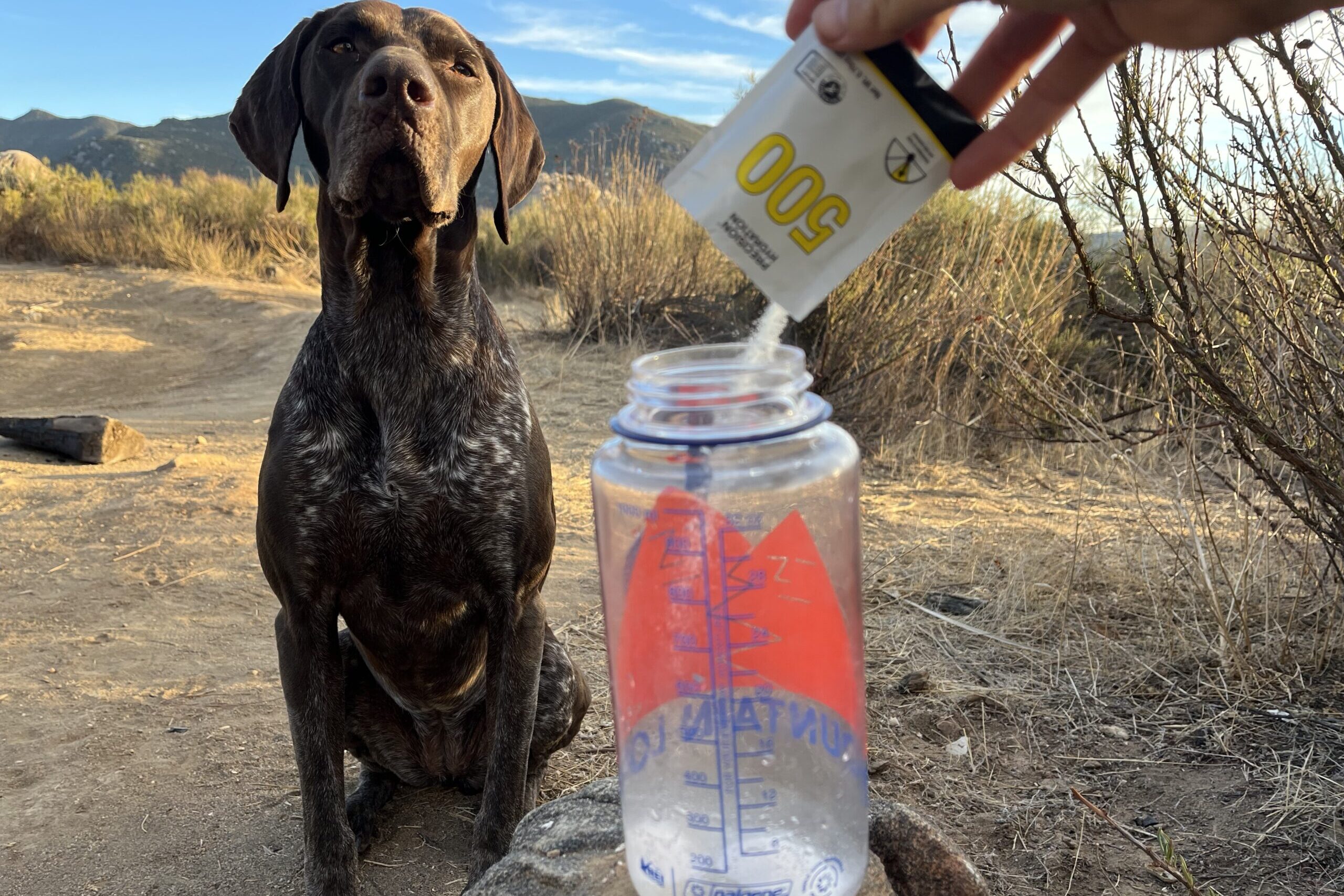
Product Comparison Table
| oSort | Product | Cost/Serving | Sodium (per serving) | Potassium (per serving) | Sugar (per serving) | Electrolyte Balance | Sugar Content | Solubility & Flavors | Third-Party Testing | Packability | 0 |
Liquid I.V. Hydration Multiplier View at Amazon |
$1.56 | 560mg | 370mg | 11g | 4.7 | 4.5 | 5.0 | 3.5 | 4.6 | 1 |
DripDrop ORS Science View at Amazon |
$1.12 | 330mg | 180mg | 7g | 5.0 | 4.5 | 4.7 | 3.5 | 4.8 | 2 |
Nuun Sport Hydration Tablets View at REI View at Amazon |
$0.75 | 300mg | 150mg | 1g | 4.8 | 4.1 | 5.0 | 3.5 | 5.0 | 3 |
Mio Hydrate View at Amazon View at Walmart |
$0.57 | 115mg | 60mg | 0g | 4.8 | 3.9 | 5.0 | 3.5 | 5.0 | 4 |
Gnarly Sports Nutrition Hydrate View at Amazon |
$0.75 | 250mg | 100mg | 4g | 4.7 | 3.9 | 3.5 | 4.5 | 4.8 | 5 |
Transparent Labs Hydrate View at Amazon |
$1.00 | 500mg | 250mg | 0g | 5.0 | 3.9 | 3.9 | 4.0 | 4.8 | 6 |
Gatorlyte View at Amazon |
$0.89 | 420mg | 300mg | 10g | 4.2 | 4.5 | 4.8 | 3.5 | 4.7 | 7 |
Nuun Endurance View at Amazon |
$1.25 | 380mg | 200mg | 15g | 4.7 | 4.3 | 3.9 | 5.0 | 3.6 | 8 |
Ultima Replenisher View at Amazon |
$0.49 | 55mg | 250mg | 0g | 3.9 | 3.9 | 4.7 | 3.5 | 4.9 | 9 |
Hydrant Fast-Acting Electrolyte Powder View at Amazon |
$0.66 | 520mg | 403mg | 0g | 4.2 | 3.9 | 4.0 | 3.5 | 4.7 | 10 |
Cure Electrolytes View at REI View at Amazon |
$1.67 | 240mg | 300-350mg | 0g | 4.0 | 4.1 | 4.0 | 3.8 | 4.7 | 11 |
Vitalyte View at REI View at Amazon |
$0.57 | 135mg | 193mg | 21g | 3.9 | 4.3 | 4.0 | 3.5 | 4.8 | 12 |
Dr. Price’s Electrolyte Mix View at Amazon |
$0.46 | 200mg | 330mg | 0g | 4.0 | 3.9 | 4.5 | 3.5 | 4.8 | 13 |
Precision Hydration 500 View at Amazon |
$0.79 | 500mg | 250mg | 17g | 5.0 | 4.3 | 3.7 | 4.0 | 4.6 | 14 |
Vega Sport Hydration View at Amazon |
$0.88 | 250mg | 130mg | 2g | 4.2 | 3.9 | 4.1 | 3.5 | 4.7 | 15 |
OSMO Active Hydration View at Amazon |
$1.55 | 265mg | 96mg | 17g | 3.9 | 4.3 | 4.0 | 3.5 | 4.7 | 16 |
LMNT View at Amazon |
$1.67 | 1000mg | 200mg | 0g | 3.5 | 3.9 | 4.2 | 3.5 | 4.7 | 17 |
Tailwind Endurance Fuel View at Amazon View at REI |
$0.80 | 310mg | 90mg | 25g | 4.2 | 4.3 | 3.8 | 3.5 | 3.8 | 18 |
Skratch Labs Hydration Sport Powder View at REI View at Amazon |
$1.79 | 400mg | 50mg | 19g | 4.0 | 4.3 | 3.7 | 3.5 | 4.4 | 19 |
Gatorade Thirst Quencher View at Amazon |
$0.89 | 230mg | 70mg | 32g | 4.2 | 3.5 | 4.8 | 3.5 | 4.7 |
|---|
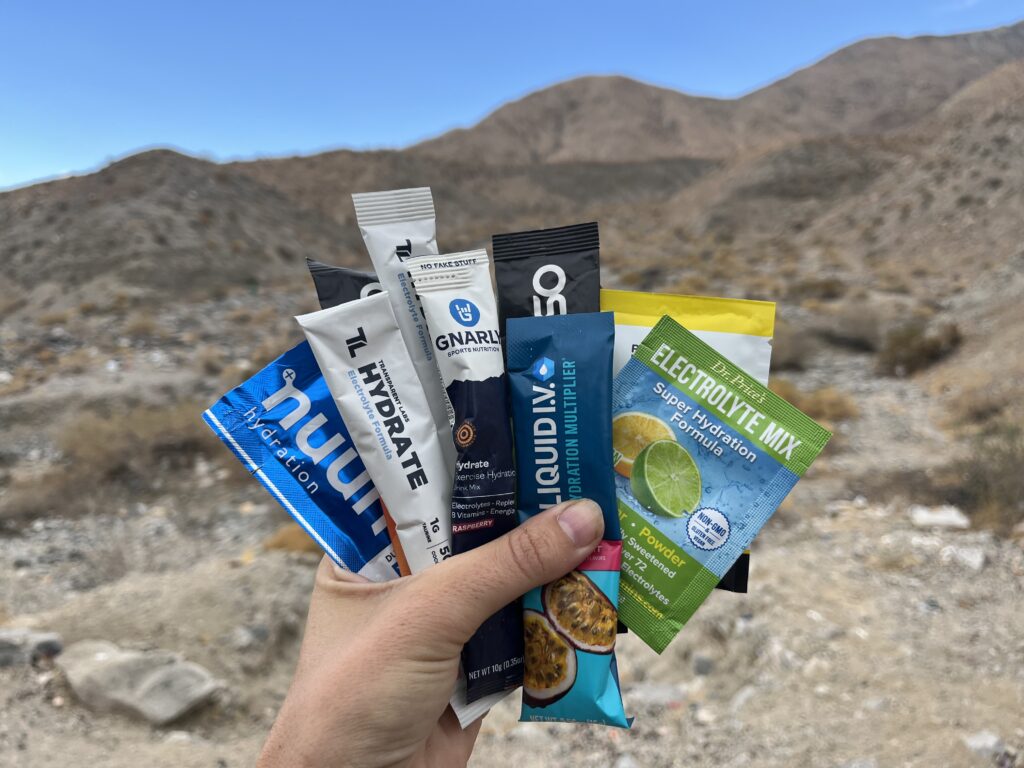
How We Test & Methodology
Our gear analysts have collectively logged tens of thousands of miles on trail, and we have tested more than 100 hydration drink mixes over many years. For the most recent update to this guide, our tester hiked, walked, and ran more than 100 miles through the California mountains, deserts and beaches of Baja, and Southern Louisiana, testing nearly 20 hydration powders along the way.
ELECTROLYTE BALANCE
We analyzed the product labels on each electrolyte powder and consulted with registered dietitians for expert opinions on the sodium-to-potassium ratios, carbohydrate content, and third-party testing.
In addition to measuring the efficacy and safety of mineral ratios, we look at overall sodium content and consider how it may play into someone’s daily food and drink consumption if not using the product only for trail days or exercise.
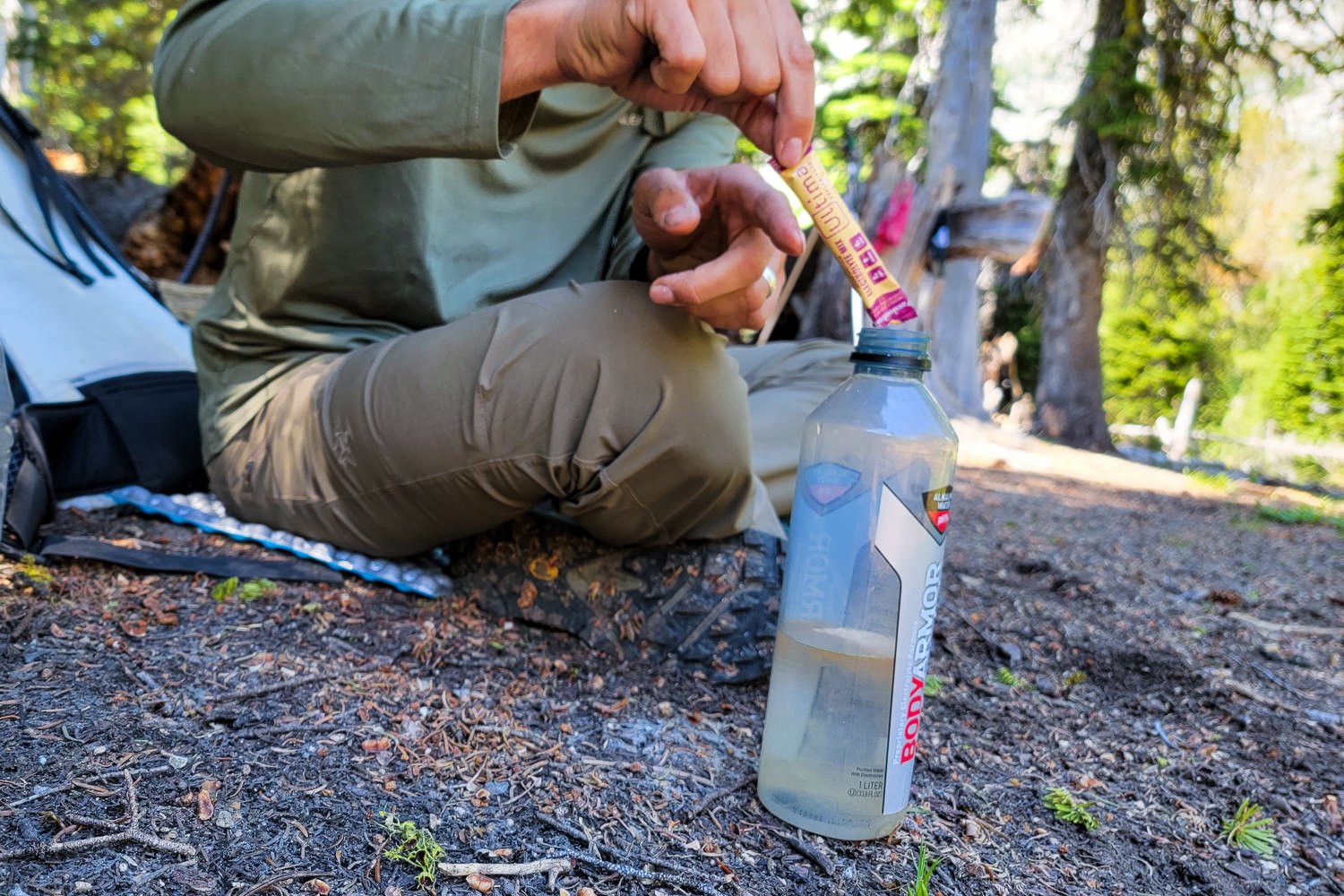
SUGAR CONTENT
We rate the sugar content of each drink mix from the perspective of a sports nutrition coach, with input from dietitians. This metric measures the sugar content in relation to sodium and potassium content because sugar helps with nutrient transport and absorption.
Sugar is important in settings where athletes are sweating heavily, while sugar-free options are suitable for daily hydration or recovering on non-trail days. We also look at which alternative sweeteners are used and their associated risks, tastes, and known side effects.
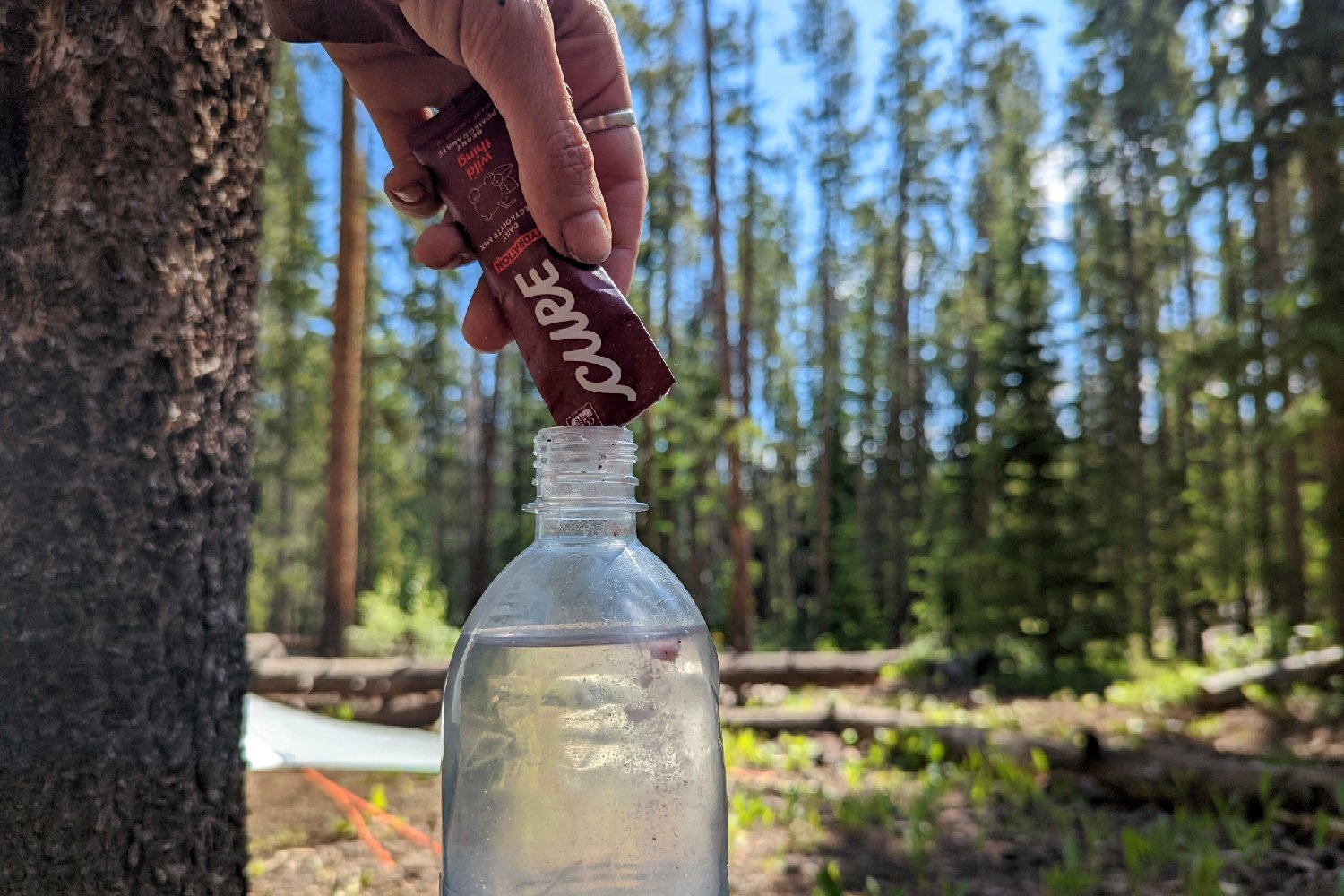
SOLUBILITY & FLAVORS
To test for solubility and taste, we taste-tested boxes of each of the powders. When possible, we purchased a variety pack in order to sample several flavors from each brand. Our evaluation for this metric includes a measure of how well the product dissolves using different methods (such as in a Nalgene versus in a glass with a spoon) and in liquids of various temperatures.
For flavors, we measure the number of flavors available, and how good or bad a product tastes. To add objectivity to our ratings, we look at customer reviews to glean a buyer consensus on different flavor options.
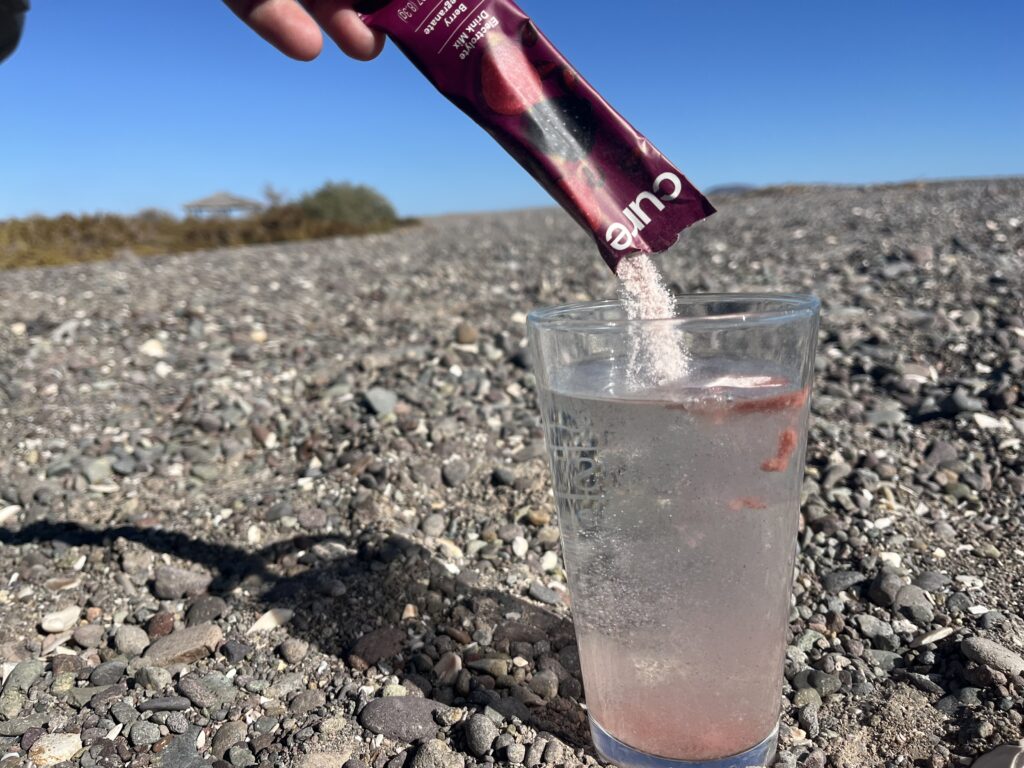
THIRD-PARTY TESTING
The most straightforward criterion, third-party testing tells us whether a supplement company cares about what it puts in its products. This measures a brand’s effort in getting their products independently vetted for impurities like heavy metals, pesticides, and other contaminants.
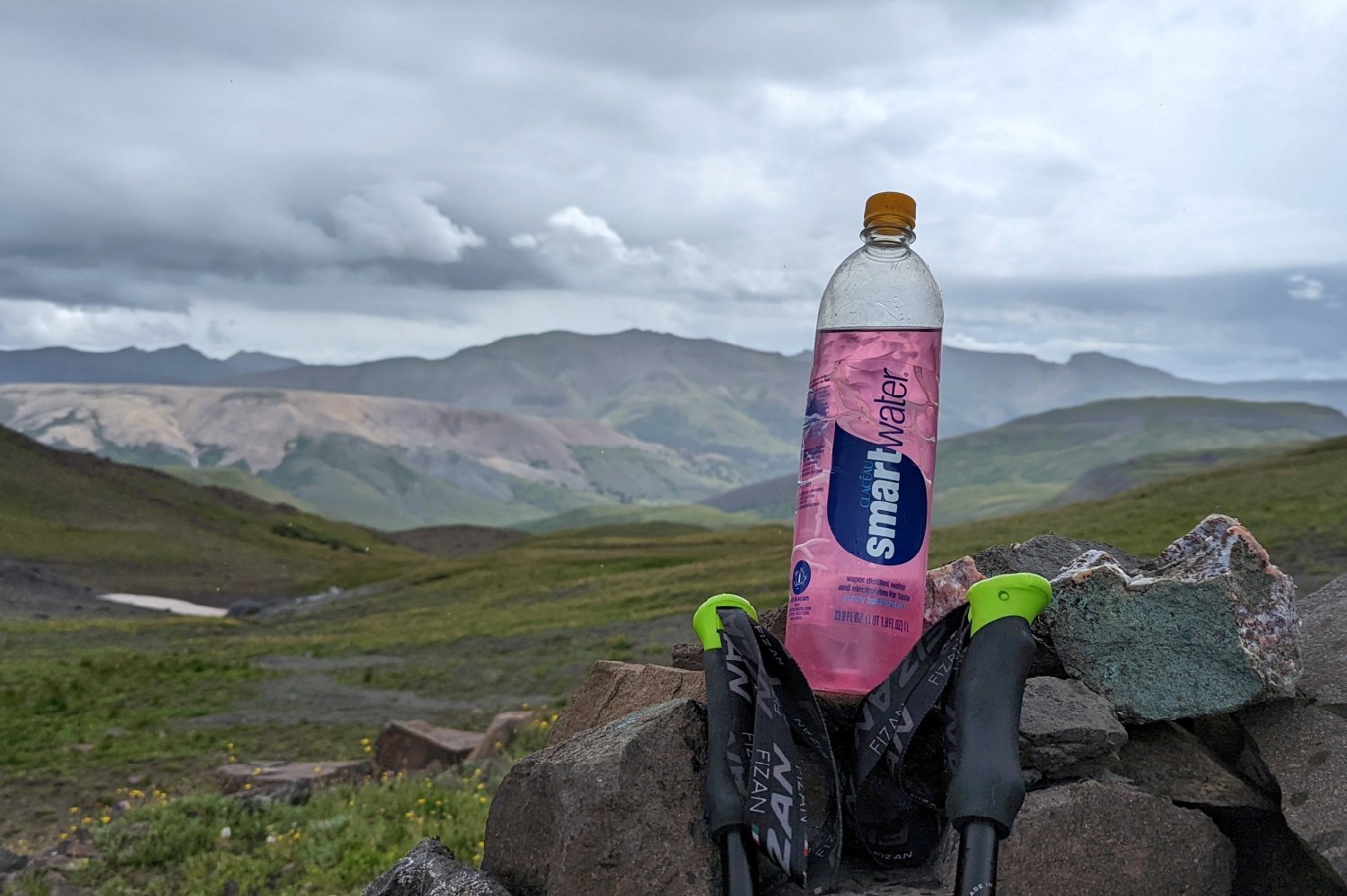
PACKABILITY
For this metric, we primarily look at the size and weight of the individual sachets, and whether they are worth packing for the nutrition they provide. We measure the weight per serving and look at other aspects of packability, such as how durable the packaging seems (will it rip in a crowded hiking pack?) and whether individual stick-packs are even available.
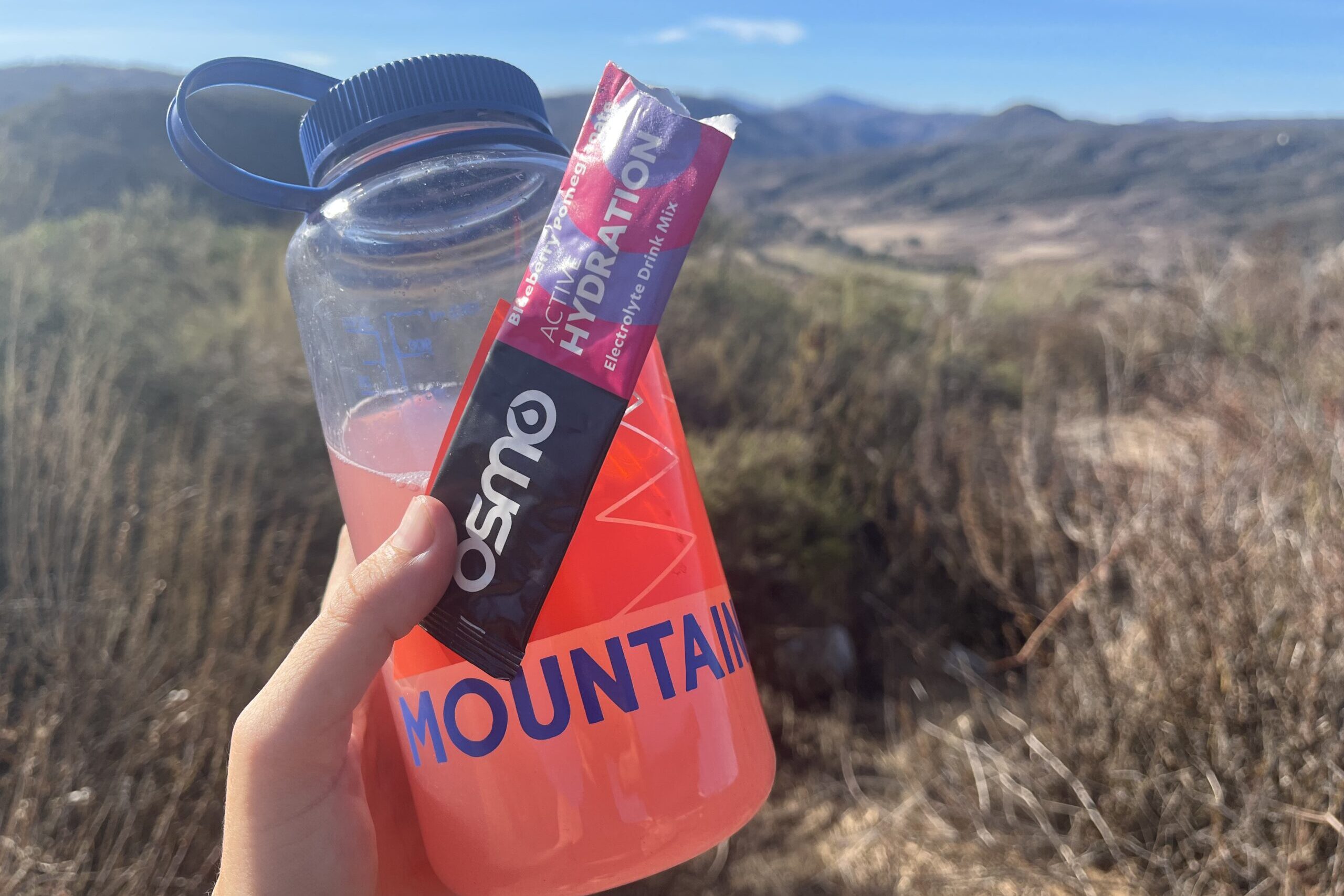
Why Trust CleverHiker
Lead gear analyst, Amanda Capritto, is a certified sports nutrition coach and certified personal trainer who not only has years of hiking experience, but has been writing in the nutrition and fitness industries for nearly a decade. She also has several years of experience coaching outdoor athletes how to fuel and hydrate during mountain adventures.
Our testers collectively have tried more than a hundred hydration mixes over more than 50,000 miles on trail; for our most recent update to this guide, we hiked and ran more than 100 miles in various environments, tested nearly 20 new products, and consulted with a registered dietitian to analyze product labels to understand the pros and cons of each powder.
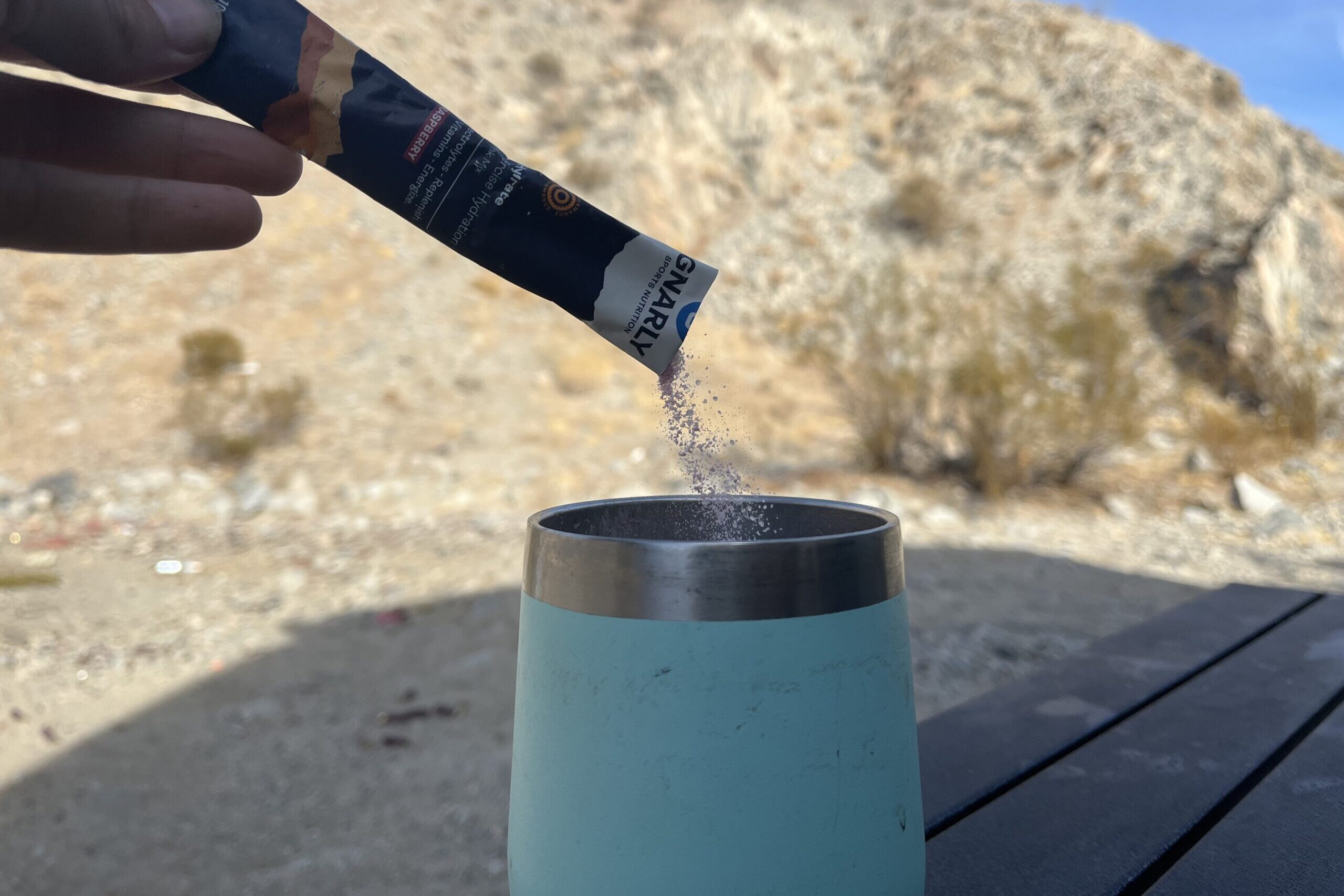
Analysis & Results
VALUE
A good hydration drink mix is invaluable for trail-goers. While we love to see electrolyte powders under $1.50 per serving, the best option for you will be worth the price even if it’s on the high end—the cost of dehydration can be higher. When you know what formula works for you, you can best support your hydration needs with an optimal ratio of sodium, potassium, and sugar.
ELECTROLYTE BALANCE
Everyone has different needs, and while the best way to find out what formula is right for you is to undergo sweat testing, it is possible to tease out some generally beneficial formulas that are suitable for most people.
As a general recommendation, registered dietitian Jaclyn Skaver says to look for 300 to 500 milligrams of sodium per serving (with 500 milliliters of water) or up to 1,000 milligrams per 500 milliliters of water for those who sweat heavily or are exercising for a prolonged period during the heat. (500 milliliters is about 16.9 ounces, or the size of an average single-use water bottle.) For potassium, Skaver recommends looking for at least 60 to 110 milligrams per serving (500 milliliters of water).
Sodium is the most important electrolyte to replenish, with potassium being a close second. Other electrolytes that play a role in performance include magnesium, chloride, and calcium. If you are deficient in any of those, choosing an electrolyte with them may help improve performance and avoid symptoms of dehydration on the trail.
Many of our top choices for electrolytes fall into the stated sodium range, including Precision Hydration PH 500, Nuun Endurance, DripDrop ORS, Transparent Labs Hydrate, Tailwind Endurance Fuel, Nuun Sport Tablets, Skratch Labs Hydration Sport Powder, and Gatorlyte. For a powder lower in sodium, consider Ultima Replenisher, Gnarly Sports Nutrition Hydration Powder, Mio Hydrate, Vega Sport Hydration, Cure Electrolytes, Osmo Active Hydration, Vitalyte, and Dr. Price’s Electrolyte Mix. For more sodium, choose from LMNT, Liquid I.V., and Hydrant.
SUGAR CONTENT
Sugar content is a bit more straightforward. According to registered dietitian Jenna Stangland, if you are active for more than two hours, an electrolyte powder with carbohydrates for energy would be beneficial. This is when you’d look for formulas like Skratch Labs, Tailwind Endurance Fuel, Osmo Active Hydration, Precision Hydration PH500, and Vitalyte, all of which have about 20 grams of carbohydrates. When hiking for extended periods of time, especially on challenging trails, these powders can provide energy in the absence of food.
For any exercise type or duration, a small amount of carbohydrates—such as what is seen in the DripDrop ORS (7 grams), Gatorlyte (10 grams), and Liquid I.V. (11 grams) formulas—speeds up rehydration by helping the gastrointestinal tract absorb sodium. Even formulas with slightly fewer carbs, like Gnarly Nutrition (4 grams) and Vega Sport Hydration (2 grams), can help with absorption compared to a sugar-free powder. Sugar-free powders are not the best option for hard trail days, but can be helpful for rehydrating once you’re off the trail and don’t need the extra sugar. They are also suitable for everyday hydration when you are less active. Be cautious of sodium intake on inactive days, and consider choosing a powder like Ultima Replenisher, which is very low in sodium but contains ample potassium.
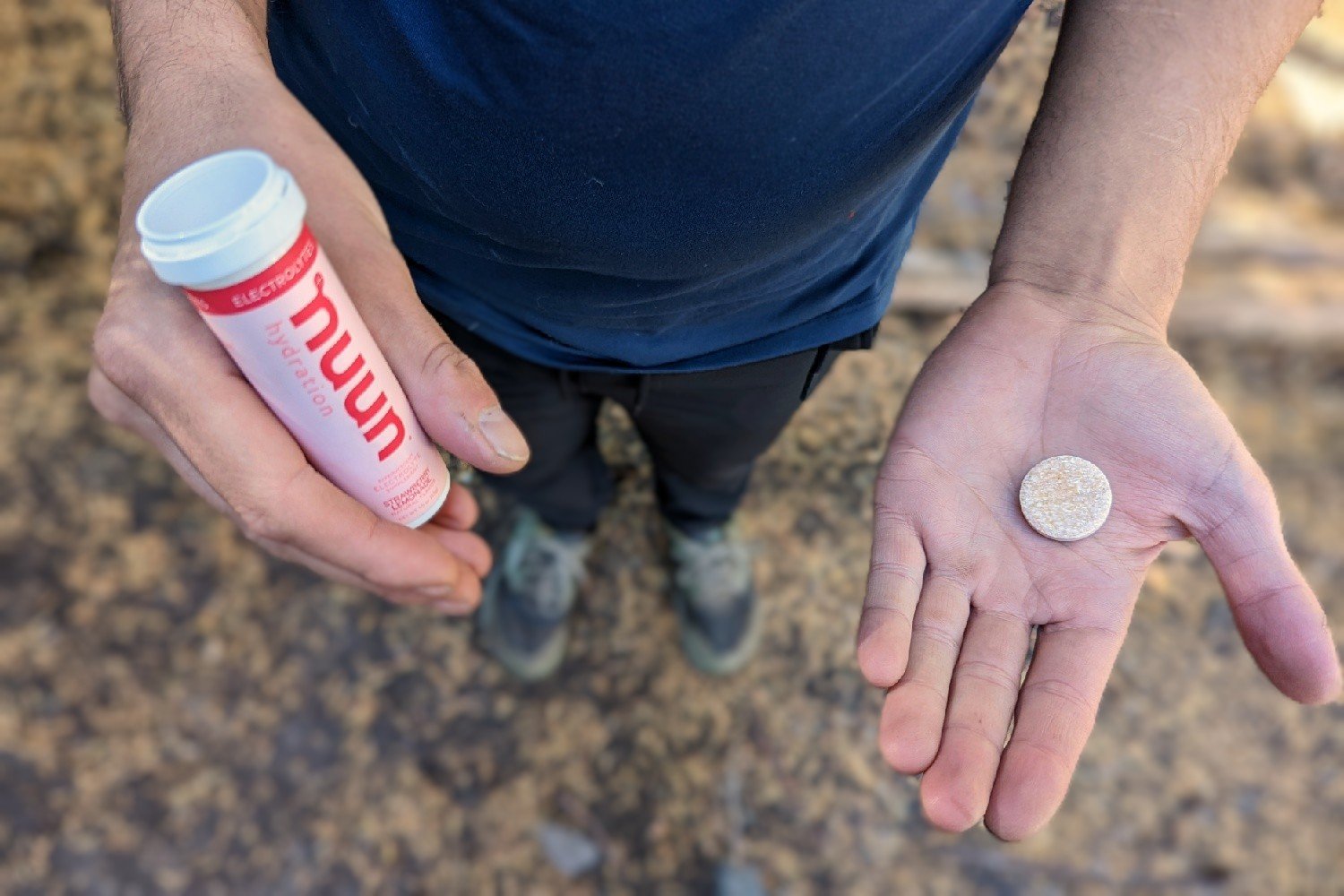
SOLUBILITY & FLAVORS
For the most part, all of the powders we have tested dissolved well, with a few exceptions. Gnarly Sports Nutrition Hydration Powder left a bit to be desired—and bits in the bottom of our cup. Transparent Labs Hydrate was the same, which we believe is due to the lack of an emulsifier or anti-caking agent like silicon dioxide.
Mio Hydrate wins us over with outstanding solubility (not a surprise, given it’s already a liquid), as do the Nuun Sport Tablets, which create a refreshingly fizzy beverage. Top-performing powders include Liquid I.V., DripDrop ORS, Cure Electrolytes, and Gatorlyte, all of which impressed us by leaving little to no residue and mixing without chunks.
As for flavor variety, Ultima Replenisher wows with 16 flavors to choose from. Liquid I.V., Cure, Skratch Labs, Gatorlyte, LMNT, and DripDrop all have respectable offerings, with seven or more flavor options. Some hydration powders only come in one or two flavors: Precision Hydration PH 500, for instance, has just a single citrusy flavor. It’s not even named, because there’s just the one. We don’t necessarily think this is a drawback, but it’s worth knowing if you are prone to flavor fatigue.
When evaluating the flavors themselves, we found ourselves drawn to Cure Electrolytes, which has bold flavors that taste true to the label. The same is true for DripDrop ORS, particularly in the berry flavor. We noticed some artificial aftertastes in a few of the powders we tried, including some flavors of Liquid I.V., Gatorlyte, and Mio Hydrate.
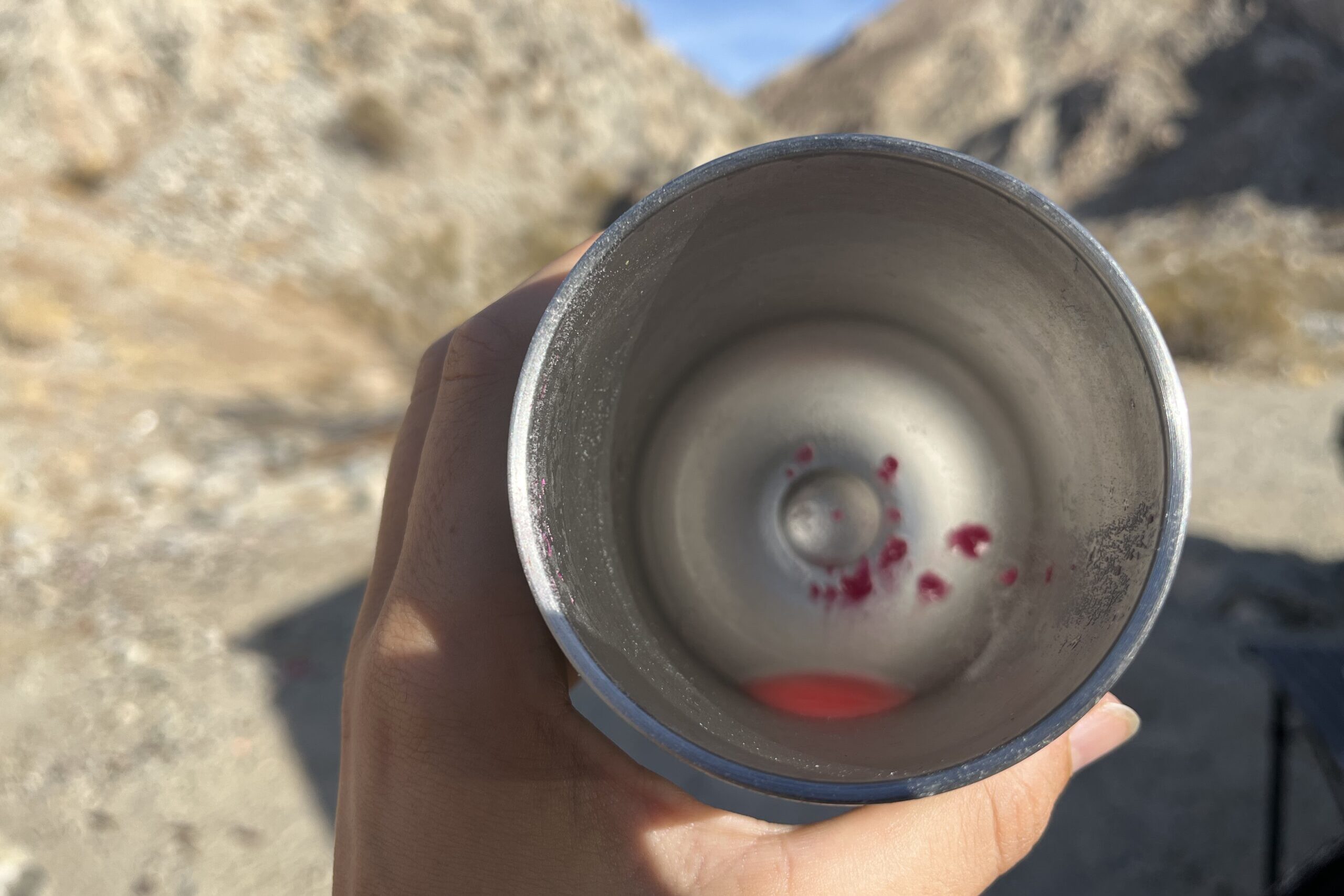
THIRD-PARTY TESTING
Third-party testing refers to independent testing of supplements. This type of testing generally analyzes the content of a supplement for impurities such as heavy metals, pesticides, allergens, and substances that are banned in sports (performance-enhancing drugs).
When an electrolyte powder is sold as a supplement, we like to see third-party testing because FDA regulations for supplements are not as stringent. Supplement companies are basically left to self-govern, and research as shown up to 90 percent of supplements could be incorrectly labeled in some way.
Transparent Labs is a clear winner for third-party testing. In fact, the entire brand is centered around, well, transparency. (Aptly named, yeah?). Not only is Transparent Labs Hydrate Informed Choice Certified by the National Sanitation Foundation (NSF)—but you can also find certificates of composition for individual batches of the powder on the website.
Many electrolyte powders are sold as foods, not supplements, in which case you’ll find a nutrition facts label (as opposed to a supplement facts label) on the packaging. We don’t worry as much over the lack of third-party testing for products sold as foods, because they are held to much stricter requirements and regulations from the FDA. If you see a supplement facts label with no third-party testing certification, consider investigating further to find out if the brand discloses ingredient sourcing or provides other elements of transparency.
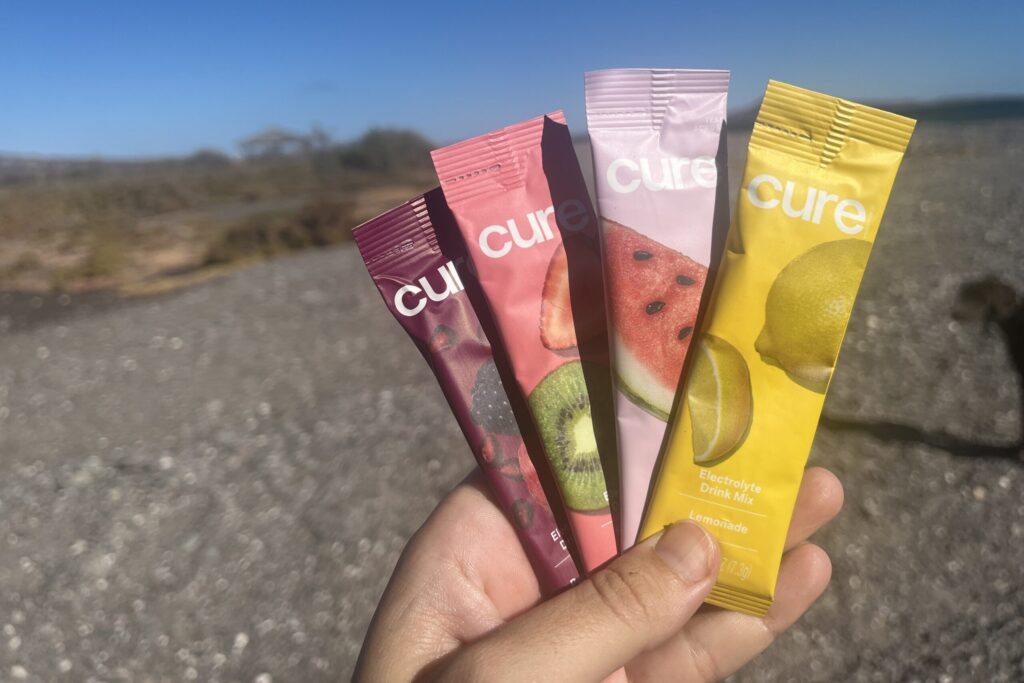
PACKABILITY
We are backpackers after all so we considered packability when evaluating the best hydration drink mixes. To do so, we looked at the size and shape of individual sachets, as well as the actual packaging to determine if there was any risk of it tearing open inside a hiking pack. In the spirit of full honesty, we didn’t find any of the powders to be more or less durable than one another. We think they’ll all perform just fine in any hiking situation.
The one thing to consider is the weight per serving. The more sodium, potassium, and sugar per serving, the larger the serving will be. You may feel opposed to packing something like Tailwind Endurance Fuel, for instance, due to the 27-gram serving size. But when you consider that the 25 grams of carbohydrates in Tailwind can replace, say, a piece of fruit, the powder may save you weight in the end. Ultima Replenisher packets are the smallest, but they are sugar-free and low in sodium, so the nutrition-for-weight ratio isn’t the best for most hikers. In the end, you may find that a middle-of-the-road formula with a moderate amount of all three key nutrients provides the best value as far as weight, packability, and nutrition.
How to Choose a Hydration Mix
WHAT ARE ELECTROLYTES?
Electrolytes are charged minerals that help your body with a ton of essential functions. Your body runs on electrical signals generated by your nervous system. All of your bodily functions – movement, muscle recovery, water absorption, etc. – rely on electrolytes to conduct these signals through your cells. There are seven major electrolytes that your body needs, but these are the six you should look for on the nutrition label of a good hydration mix.
Sodium: Helps your body maintain the right balance of fluid inside and outside of your cells
Chloride: Helps maintain pH balance
Potassium: Works with sodium to help maintain a balance of fluid in your cells
Magnesium: Helps with energy production
Calcium: Helps muscles contract, regulates heart rhythm & nerve function
Phosphate: Won’t always be listed; a building block your cells use to create energy
ELECTROLYTE BALANCE
The key to choosing the right formula for you is knowing how you sweat. Taking a sweat test is the only true way to determine this. It’s a two-part endeavor, with one part measuring actual fluid losses (weighing yourself before and after exercise, adding in the weight of fluid consumed) and one part measuring sweat sodium concentration (a sweat patch can accomplish this in a rudimentary way).
If you don’t have the resources or time to pursue this, it’s generally effective to stay within Skaver’s stated ranges: 300 to 500 milligrams of sodium and 60 to 110 milligrams of potassium. Consider a higher-sodium product or doubling up on the serving for extended trail days, multi-night trips, and particularly hot weather.
SUGAR CONTENT
Ideally, an electrolyte powder has at least a small amount of sugar to speed up the absorption process so that your body actually uses the sodium you are consuming. Look for sugar content in the range of 4 to 12 grams for that purpose. If you want a hydration powder that also serves as a fuel source, look for at least 15 grams of carbohydrates, but ideally 20 grams, especially if you’re planning to use it in place of solid food. Sugar-free electrolyte powders have their place, but are not the most effective option for absorption and rehydration. They can be helpful when you need a hydration boost on less active days. Choose one that’s also lower in sodium for that purpose.
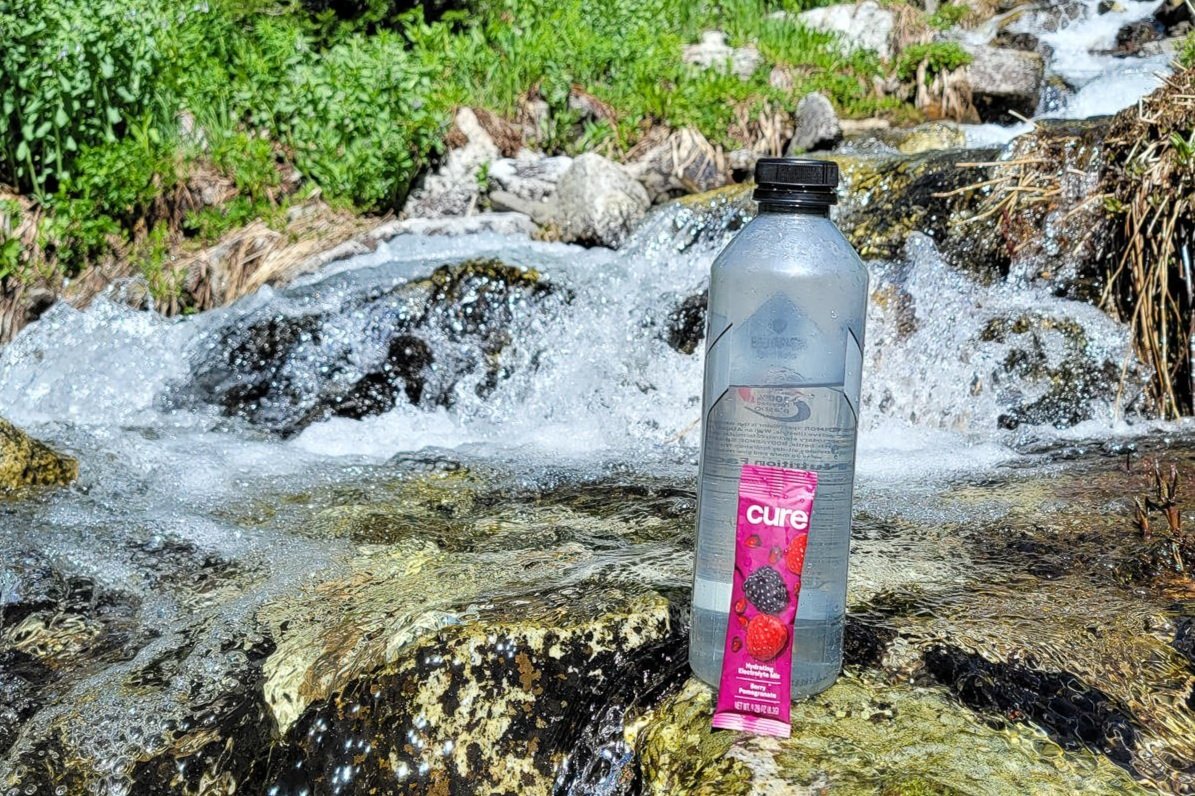
SOLUBILITY & FLAVORS
We’ve found that most hydration powders mix well, at least in a bottle. That is not always the case when mixing with a spoon. If solubility is a concern of yours (a.k.a. chunks gross you out), you’ll want to make sure you choose a powder that has some sort of anti-caking agent. Most often, this is present as silicon dioxide. Those who are prone to flavor fatigue may want to choose a product that comes in a lot of different flavors and from a company that offers variety packs.
THIRD-PARTY TESTING
If the product is sold as a supplement (has a supplement facts label), look for indications of third-party testing and label transparency. Typically, if a brand has put their product through third-party testing, that information will not be hard to find. If the product is sold as a food (has a nutrition facts label), third-party testing is not as much of a concern, since foods are more tightly regulated by the FDA.
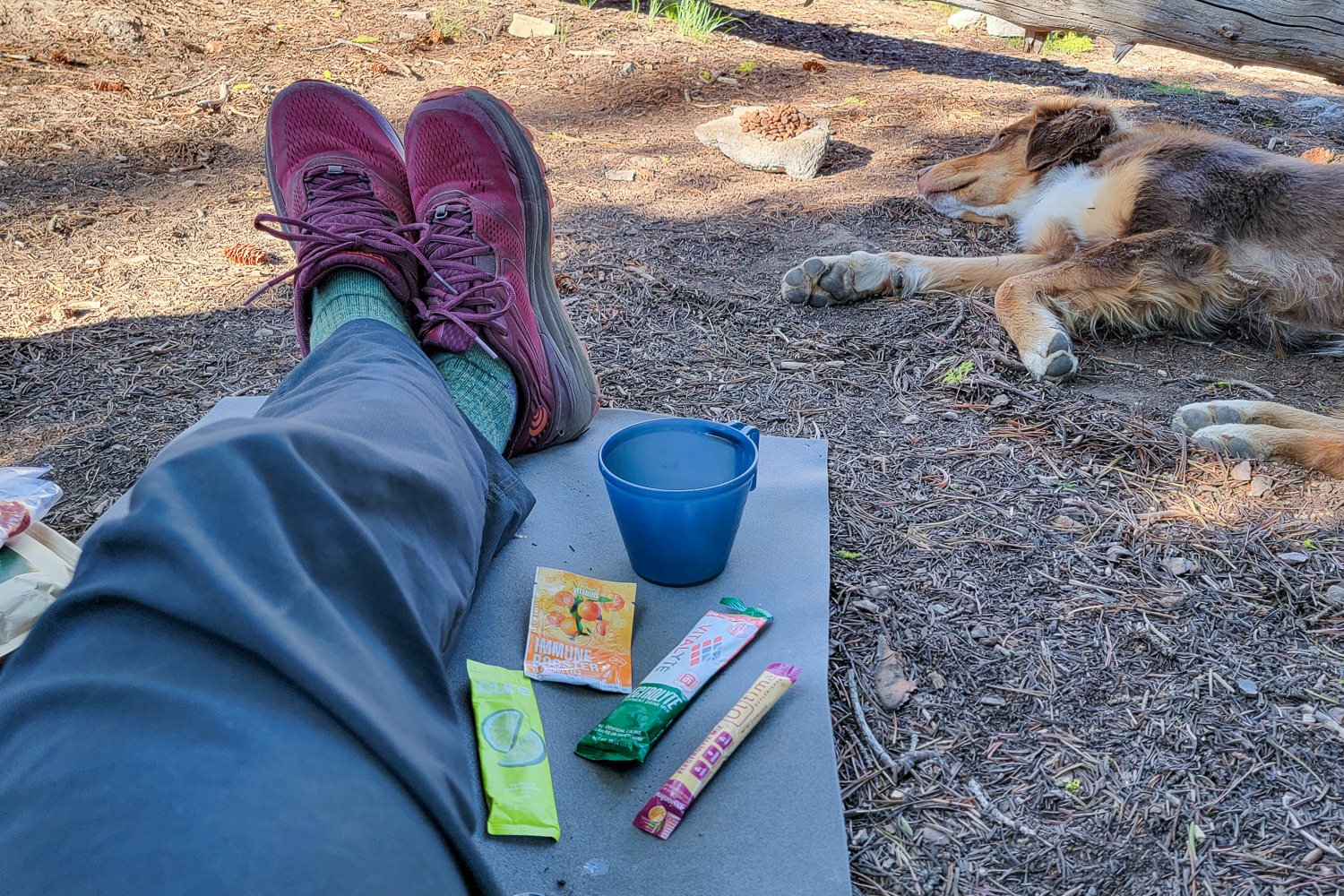
PACKABILITY
In general, any electrolyte powder that comes in individual stick-packs or sachets will be easy to pack. Some packets are larger, but typically, the larger packets include more nutrients. If you’re choosing a powder with carbohydrates, be sure to factor that into your overall nutrition plan so you don’t pack more weight than necessary.
LEAVE NO TRACE
Many electrolyte powders come in small, individually wrapped tear sticks. You rip off a tiny piece of the top then pour the powder in, and now you’ve got two very small pieces of garbage that can easily be lost. If you’re not in a position to throw the packaging away immediately, make sure you have a Ziploc or another receptacle handy to securely stash the trash until you’re able to dispose of it.
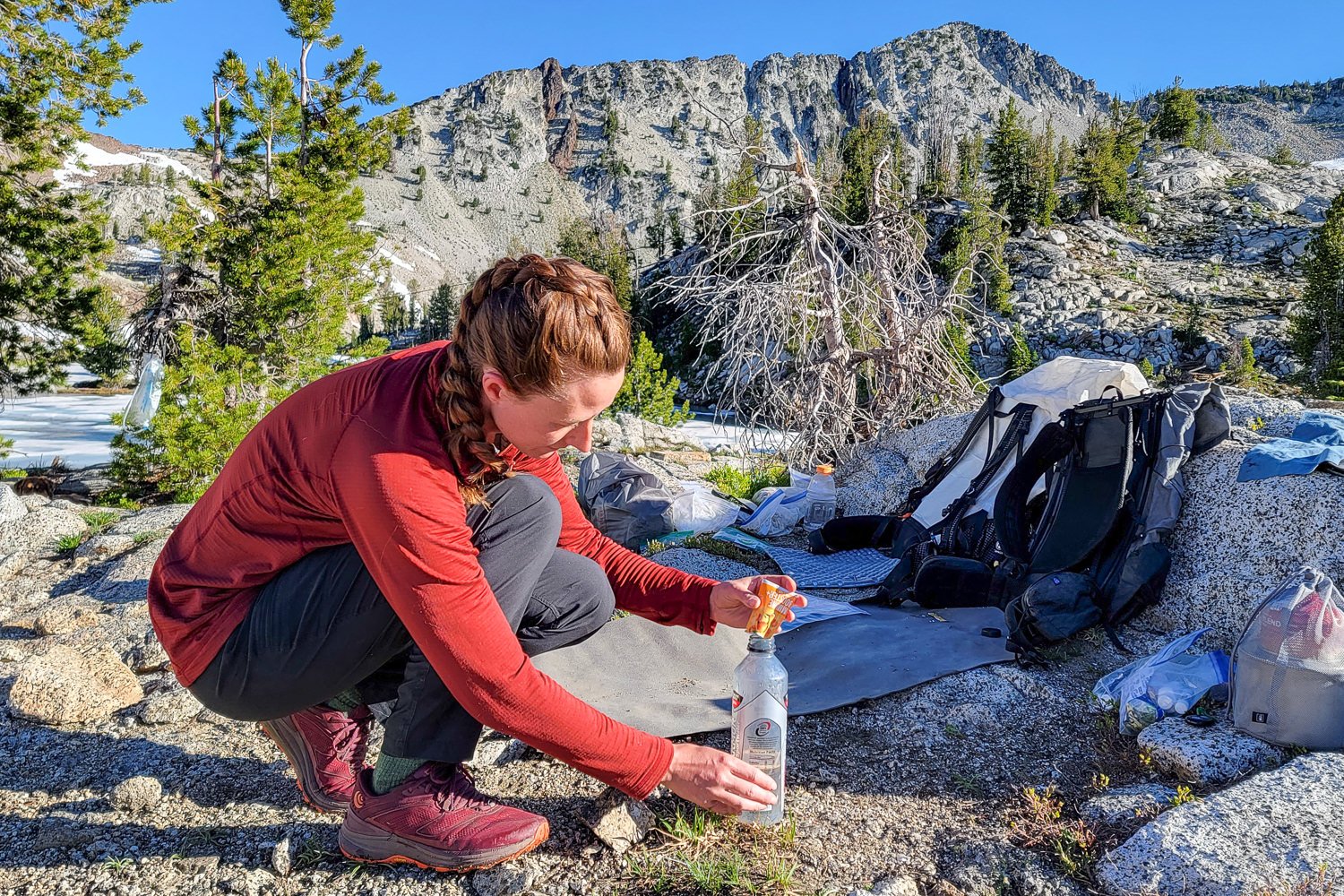
Conclusion
Hydration is crucial in the backcountry. Getting the right balance of electrolytes to keep yourself going mile after mile can be tricky and there are a lot of options to consider. However, if you’ve made it this far, you know our team of gear analysts with the support of certified nutritionists and dietitians can help you be at your best. Happy trails!


